![]()
![]()
![]()
Group & Last Name Index to Full History:
A B C D E F G H I J K L M N O P Q R S T U V W X Y Z
Composers are listed chronologically. Tracks are listed alphabetically.
Find on Page = F3. Not on this page? See history tree below.
Chronological
Featured on this page in order of the composer's birth date.
|
This page aspires to index some of the medieval and renaissance composers
who predated the classical era. The roots of classical music are buried in
the Catholic Church, both Orthodox and Roman, its earliest expressions in
chants and hymns. It's first secular influences would not arise until
several centuries later with the roaming troubadour. Due that specific dates
are largely impossible with most medieval and Renaissance music, coupled
with there no recording being done, this section is structured differently
from those of the 20th century. One: dates in the menu above represent
births rather than debut issued recordings. Two: the system used is
alphabetical rather than chronological: titles below text are listed
alphabetically regardless of dates. As for
compositions, publication dates may substitute. Posthumous publishing dates
are generally not noted. If the composer you're seeking isn't on this page
try
Baroque. Nice glossary of musical terms for this period at
ORB.
For an encyclopedic history of classical music see 'All Music Guide to
Classical Music: The Definitive Guide to Classical Music' (Hal Leonard
Corporation 2005). Best Classical Tunes begins a nice Timeline of classical
composers with Josquin des Prez (b. 1440 also cited as c 1850-55). See also
the lists of composers at Classical Archives,
Classical Net
and mfiles. As the history of classical music is largely European until its later
arrival to the United States in the 19th century, helpful in the use of this
account may be
chronological maps of Europe and its monarchs mentioned throughout
[1,
2,
3,
4]. The
earliest major European temporal power to which this history refers
throughout is the Roman Catholic Church and the
Papal States. Much of the
history of Europe is likewise that of the Holy Roman Empire (HRE) from the 9th
to the 19th centuries [1,
2,
3;
HMEA].
France
was a major player alongside the
Church in medieval music prior to the Renaissance and
became the major European check to the HRE. Venice didn't acquire a lot of territory
but became a major cultural center during the Renaissance alike
Italy
of which it became a part in 1866. Other
European nations important to these accounts include in alphabetical order
Austria,
England [GB UK: 1,
2],
Germany,
Poland [1,
2],
Prussia [1,
2],
Russia and
Spain. Also
much affecting European music was northern Europe or, Scandinavia
[1,
2,
3],
particularly as an adversarial check to Russia.
Quick dates for monarchs and popes:
1,
2,
3,
4. See also America [1,
2]. |
||
| The
Medieval period of music is generally said to extend from year 476 to 1400.
Though Emperor Constantine had already built the old St. Peter's Basilica
[*] in Rome in the early 4th century, not until the ninth century would such as Armenian, Byzantine and Frankish
composers come to be lastingly documented. As for those earlier, if this history begins circa 500
AD it begins at the dawn of the Dark (Middle) Ages upon the fade
of the Western Roman Empire, its last emperor, Julius Nepos, having been
assassinated in 480. Emperor of the Eastern Roman Empire, Zeno, ran the
Mediterranean from Constantinople. Attila the Hun had only recently ceased
to be a threat to both empires upon his death in 453. Despite pressing
barbarians, that is, creatures not Roman, Christianity had been slowly
growing in the West the way a tree takes root in the crack of a rock. By 500
AD the Catholic Church had been through fifty popes [*] if count Peter
and the seat was in contest between Symmachus and Laurentius. St. Brigid had
founded Kildare Abbey in 490, a monastery in Ireland destroyed seven
centuries later [*]. Clovis had managed to convert Franks to Catholicism in 496. Zeno was head
of the Eastern Orthodox Church from which Alexandrians in Egypt split to
create the Coptic Orthodox Church in 497. Christian hermitage had been in
full swing for a few centuries now, ironically famous during this period being the
Grecian Eastern Orthodox Cyriacus the Anchorite
[*]
who died at the Cave of St. Chariton in Palestine above one hundred years
old in 557, also venerated by the Coptic Church. Oriental Asia in the Far
East was as distant as the Big
Bang so far as Western civilization yet forming was concerned. It was about
500 AD that the Frankish Kingdom was wrought while across the Channel the
Kingdom of Essex was founded by the invading Anglo-Saxons (Germanic). The legendary British King Arthur is supposed
to have been active in 500 AD, perhaps leading the Battle of Mons Badonicus
against Anglo-Saxons in 497. The Anglo-Saxon claim to England would be
contested continuously for centuries to come [*].
Farther northeast, it was about 500 AD that Goths (Germanic), who had sacked
Rome in 410 AD, founded the first Swedish state called Svealand. Such
civilization's
setting in general into which
Romanos the Melodist
was born circa 490 in Syria, a Greek Byzantine hymnographer who composed
for both the Eastern and Western Catholic Church, though he largely wrote
kontakia (hymns) for the Eastern Church. Thought to have been a Jew born in Emesa
(now Homs) or Damascus, Romanos became a deacon in the Church of the Resurrection
upon traveling to Beirut. He soon moved onward to Constantinople where he is
thought to have lived during the reigns of Anastasius I, Anastasius II and
Justinian, serving as a sacristan (church keeper) in the Hagia Sophia (Great
Church *). Romanos is
generally, if not certainly, credited with writing the Akathist Hymn
in thanksgiving to the Mother of God [1,
2,
3,
4,
5,
6] on
an unidentified date and
would later be sainted a patron for singers by the Eastern Orthodox Church. Romanos died approximately 556 in Constantinople. 'Kontakion of the
Nativity' [1,
2] is his best-known
work, dated to 518, followed by a second
[*] of unidentified date.
Romanos died approximately 556 in Constantinople.
References: 1,
2,
3,
4.
Discography containing works of
*. Bibliography: 'The Story of Civilization IV: The Age of Faith' by Will
Durant (Simon & Schuster 1950): 1,
2;
'Writing and Redemption in the Hymns of Romanos the Melodist' by Derek
Krueger (U of Birmingham 2003) *.
Other profiles: 1,
2,
3,
4.
The Melodist's kontakia
[1,
2,
3,
4]
would have been sung in the Constantinoplian Greek of his period. Romanos the Melodist Active 6th century Khouria Frederica
|
Romanos the Melodist Depicted with the Theotokos (Mother of God) Source: St. Peter & St. Paul |
|
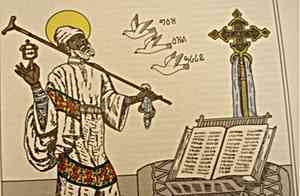 Yared Source: Black Past |
Yared
(505-571) was a contemporary of
Romanos the Melodist,
being about fifteen years younger. His name was taken from Jared in the book of
'Genesis', said to have been the father of Enoch. That Jared is reputed to have
lived 952 years, his the sixth of ten generations from Adam to Noah, when
it's said per Enoch that angels descended to Earth. As for Yared, during the
years he shared in common with
Romanos (c 490-557)
Rome went through about ten more popes whilst Ireland got dotted w a few
more monasteries, well on its way to becoming as Catholic as Rome. Across
the Strait of Dover in England, Anglo-Saxons had acquired control of Sussex,
Kent and East Anglia with all of Yorkshire at their horizon. Justinian I had
become Caesar of the Byzantine Empire in 526, also head of the Eastern
Orthodox Church until his death in 565, the glory days of the Byzantine
Empire closing with him. Yared in the meantime is
thought to have originated the zema (chant) tradition of the Ethiopian
Orthodox Church, a part of the greater Coptic Orthodox Church of Alexandria
said to have been founded by the 'Gospel' author, (Saint) Mark. Yared is
known to have composed five volumes of chants for the Ethiopian Church.
Yared is also known to have performed for Ethiopian Emperor, Gabra Masqal
(550-64). Wikipedia continues the traditional story of Masqal accidentally
dropping a spear on Yared's foot. To compensate he granted Yared's wish to
be able to live in solitude in the Semien Mountains in northern Ethiopia,
where he died a recluse in 571. References: Wikipedia.
Further reading: Ayele Bekerie;
Ethiopian Press Agency.
Other profiles: 1,
2,
3,
4,
5. Like the
Melodist, sixteen centuries have
passed since Yared composed, thus the samples below may be better regarded
as approximations than faithful renditions. Per below, 'Mahelete Ze Asterio
Mariam' translates to 'The Hymn's of St. Yared for the Feast of Virgin
Mary'. Yared Active 6th century Kidist Mariam/Debre Tsige, Ethiopia Kidist Mariam/Addis Ababa, Ethiopia
|
|
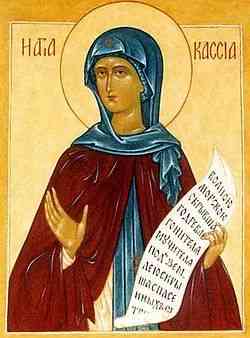 Saint Kassia Source: Wikipedia |
Born in either 805 or 810 in Constantinople,
Saint Kassia
was daughter to wealthy parents with proximity to royalty, such that she was
among the contestants at the bride show during which soon-to-be Emperor
Theophilos chose his bride circa 830. The bride show was an event known to
occur in ancient Greece by which a potential husband strolled between two
lines of females with a golden apple to award to his choice of wife. It was
practiced in 8th and 9th century Byzantine as well (and tsarist Russia). It
was also customary for women to be submissively quiet. It's said that as
Theophilos approached her he remarked upon the evil of women in reference to
Eve: "Through a woman came forth the baser things" (verbatim by tradition).
Kassia might have become an Empress had she kept silent, but she replied
instead as to the good of women in reference to the Virgin Mary: "And
through a woman came forth the better things". Not pleased, Theophilos
passed her up, the less argumentative Theodora to gain the apple. With that
romance nipped before bud Kassia disappeared from history until slightly prior
to Theophilos' death in 842, tradition finding him attempting to visit her
at a monastery of the Orthodox Church. In 843 Kassia founded her own
monastery at Constantinople and became its abbess. As for her compositions,
fifty of her hymns are yet extant, 23 of which occupy the liturgy of the
Orthodox Church. Among the best known of her hymns were and remain 'The
Fallen Woman' and 'Augustus, the Monarch'. Kassia also left behind a large
block of secular writings such as philosophical aphorisms. Eventually
leaving Constantinople, Kassia traveled in Italy a bit before settling on
the Greek island of Kasos before dying prior to 866. She was sainted by the
Eastern Orthodox Church in 867. References: 1,
2,
3.
Discographies containing works
of: 1,
2,
3,
4.
Further reading: 5Harfliler;
Theresia Kraienhorst;
Diane Touliatos.
Other profiles: 1,
2,
3,
4. Kassia Active 9th century Vocal: Jessica Suchy-Pilalis
|
|
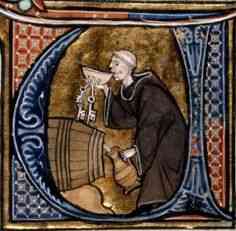 Hucbald Source: Geni |
The Catholic Church puts
Hucbald's
birth at 850, other sources about 840 in northern France. Either way, the
Roman Church had been through 100 popes by the time of his birth.
Scandinavian Vikings had begun to raid England, Scotland and Ireland in
793-795, which action would continue into the 11th century. The Byzantine
Empire had meanwhile been getting argument since 780 from Arabs and the
Muslim Abbasid Caliphate also in conquest. That would continue for
several centuries until Constantinople eventually fell to the Ottoman
Caliphate in 1453. Meanwhile, Charlemagne, King of both the Franks and Lombards, had been made Holy Roman Emperor in 800 AD by proclamation of Leo
III, Emperor of the Byzantine Empire. As for Hucbald, he begins the shift in
this history from the Eastern Orthodox Church seated in Constantinople to
the Western Roman Church in Europe. Music had long since variously developed
in sophistication by then. Though the Roman Empire had produced no musical
system of its own [1,
2], it borrowed from music theory earlier developed by the
Greeks [1,
2,
3,
4]. The
Byzantine philosopher and senator, Boethius [*], himself a contemporary of
Romanos and
Yared (above), had addressed music theory [1,
2] among other
of his interests in the early 6th century. Born c 480–524 AD, Boethius' 'De Institutione Musica'
concerned the spheres (worlds), harmony and instrumental music. As for Hucbald, like all Europe in the arts and literature for centuries to
come, he found in ancient Greece a reason to write his own work in music theory
circa 880,
'De Harmonica Institutione' [1,
2], in which he examined Grecian modes (major scales: do re mi... and variants). Hucbald was a
Benedictine [*] monk after the manner of St. Benedict [*],
the latter born in Umbria, Italy, perhaps the same year as
Romanos the Melodist
in Syria. Hucbald's early interest in ancient Grecian music theory would attend
classical music for centuries to come and be a major subject of study at
later conservatories. In Hucbald's case it was a matter of reconciling the
secular with the Church and the Gregorian chant (per Pope Gregory I who had held
the Papal seat from 590 to 604). Hucbald
also wrote poems, hagiographies (lives of saints) and hymns. Though said to
have written four Catholic offices (prayers), at least two if not all are
disputed. Among those is the 'Office of Rietrudis'. What musical composing Hucbald
may had done was textual, he leaving behind no scores since
Guido da Arezzo, another
Benedictine monk, wouldn't invent the staff (stave UK) until the 11th
century. Until that time less precise methods were used to indicate notation
referred to as neumes [1,
2,
3], discussed by Hucbald in his 'De
Harmonica Institutione' [1,
2].
He was at one time erroneously credited w writing the anonymous 'Musica
Enchiriadis' [*] which
probably appeared during his lifetime in the latter 9th century. Hucbald
died on 20 June 930. References: 1,
2;
offices and: 1,
2.
Further reading: Internet Archive: 1,
2;
'Interpreting Hucbald on Mode' by Sarah Fuller (Journal of Music Theory 2008); modes:
1,
2,
3,
4,
5,
6,
7,
8;
musical notation prior to the staff: 1,
2,
3,
4,
5. Biblio: 'The Cambridge History of
Western Music Theory' edited by Thomas Christensen (Cambridge U Press 2008);
'The Critical Nexus' by Charles Atkinson (Oxford U Press 2009);
'The 'De Harmonica Institutione' of Hucbald of St. Amans' translated by Richard Wingell (Holy Names College 1969);
'A History of Music' by Stanford-Forsyth (Macmillan 1916);
'The Study of Medieval Chant' edited by Peter Jeffery (Boydell & Brewer 2001).
Other profiles: 1,
2. |
|
|
Born circa 850 in Belgium,
Etienne de Liege
(Stephen de Liege) left behind little more music than information about his life,
but as he wrote hymns for liturgical and rhythmical offices, he makes a nice
space to remark, if ever so briefly en passant, on those essential aspects of
Roman Catholic music.
Liege was abbot of a Benedictine monastery in Lobbes, Belgium, and canon of
Metz Cathedral in Lorraine, France. Among works attributed to Liege are the
office, 'In Festi Sanctisissimae Trinitatis', and the celebration of the
Feast of the Holy Trinity. Liege also wrote hagiographies (lives of saints).
It was during Stephen's lifetime in the latter 9th century that one of the
more important books of the medieval period addressing music appeared, that
the 'Musica Enchiriadis' ('Musical Handbook') [*] by an anonymous
French author
followed by its commentary, 'Scolica Enchiriadis' [*]. 'Musica Enchiriadis' was
the first research in polyphony [*]. Introducing such as the organum [*], which
begins simply by adding one voice to another, by the time the work ends the
author has also introduced one of the more important concepts in music, that
being counterpoint, of which
Johann Sebastian Bach
would make thorough use several centuries later. One way to grasp
counterpoint is to think of two distinct melodies sung at once, which didn't
happen all at once, but gradually developed from Liege's early examinations
of polyphony. Liege had been the bishop of Liege from 901 until his death in 920.
References for
Liege: 1,
2.
Works of: 1,
2,
3.
Bibliography: Liege: 'Étienne de Liége: L'école musicale liégeoise au Xe siècle' by Antoine Auda (Academie Royale de Belgique 1923)
*;
'L'Office de la Trinité d’Étienne de Liège (901-920)' by Florence Close (Revue Belge de Philologie et d'Histoire 2008)
*;
music of the Roman Catholic Church:
'Catholic Church Music' by Richard Terry (Greening & Co. 1907) *;
'The Catholic Encyclopedia Vol 1' (Robert Appleton 1907) *;
'A History of Music' by Stanford-Forsyth (Macmillan 1916) *.
References for offices: hymns for the Divine Office (Liturgy of the Hours)
1,
2;
liturgical: 1,
2,
3,
4,
5;
rhythmical: 1,
2,
3,
4.
References for contemporary Church music: 1,
2,
3,
4.
References for counterpoint:
1,
2,
3,
4,
5,
6,
7;
species: 1,
2.
Further reading: 1,
2. Biblio: 'Musica Enchiriadis and Scolica Enchiriadis' translated by Raymond Erickson (Yale U Press 1995) *.
Etienne de Liege Active 9th - 10th century In Festi Sanctisissimae Trinitatis
|
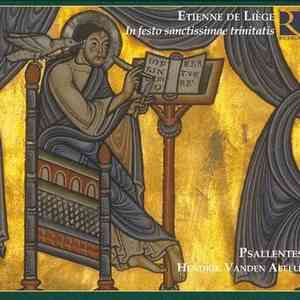 Etienne (Stephen) de Liege Source: Christ Church Cathedral |
|
|
Born circa 991 in Italy,
Guido da Arezzo
was a Benedictine monk and music theorist who left behind texts but likely
no compositions. Being nine years of age when the calendar rolled into the
second millennium AD, Sylvester II was Pope at the time, the first Frank
called to the papacy. 1000 AD also witnessed Christianity's claim to
Greenland and Iceland, Sweden eight years later. As for Arezzo in climate
more clement, one cause that he populates this page is his invention of
solmization [1,
2] sometime after 1028: ut, re, mi, fa, sol and la for the six
tones of the hexachord: C, D, E, F, G and A. Not long afterward the diatonic
scale of seven notes came into use, si (ti) added, do eventually replacing
ut. (The octave wouldn't be developed in classical music until a few
centuries later.) Arezzo also expanded the customary two-line staff (stave
UK) to four,
adding one red and one yellow [1,
2,
3]. Musical
notation prior to the staff [1,
2,
3,
4,
5] was written textually via
neumes [1,
2,
3,
4]. The five-line stave would appear in 13th
century Italy. (Six lines were also somewhere developed and used as late as
the 16th century.) Arezzo is also a principle figure for his 'Micrologus de
Disciplina Artis Musicae' (c 1025) yielding knowledge of his period. He died
sometime after 1033. References: 1,
2,
3.
Compositions: 1,
2,
3.
Further reading: 'Guido of Arezzo and His Influence on Music Learning' by Anna Reisenweaver (Cedarville U).
Biblio: 'A History of Music' by Stanford-Forsyth (Macmillan 1916).
Other profiles: 1,
2,
3,
4,
5. Per 'Ut Queant Laxis' below (which translates to 'May
Be Loosened'), Arezzo wrote the text though not likely the melody
(traditionally, though mootly, ascribed to Paulus Diaconus [Paul the
Deacon]). Arezzo is thought to have applied an ancient text by Horace (4.11:
'Ode to Phyllis') to the already existent melody, altering it for its
alternative title, 'Hymn to John the Baptist'. Howsoever, the example below
reveals the solmization used in the first stanza. Guido da Arezzo Active 10th century Office Full text
|
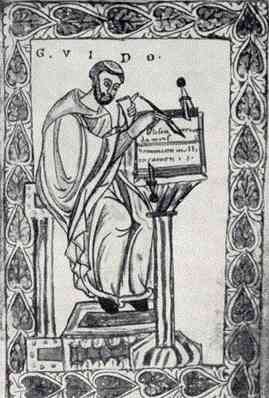 Guido da Arezzo Source: Longwood University |
|
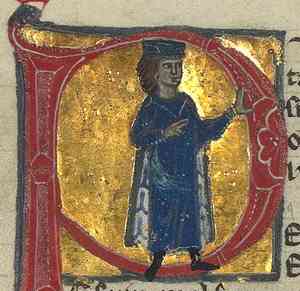 Guillaume (William) IX Source: Wikimedia Commons |
Born on 22 October 1071 in France,
Guillaume IX d'Aquitaine
(aka Guilhen de Peiteu and Guillaume de Poitiers) was also known as Count of Poitou
(Count of Poitiers). As a composer he chronologically follows Hermann of Reichenau (1013-54), long famous for hymns he didn't
write, such as the final prayer of the Rosary, 'Salve Regina' ('Hail Holy
Queen'), now considered anonymous. Guillaume IX, however, has the problem of
only a fragment of one his melodies surviving, albeit a
number of his poems, eleven to be precise, remain. By the time Guillaume arrived
to this Earth the Vikings had ceased their two and a half century
terrorization of all of Europe when Norwegian King
Harald III (Harald Harðráða) was defeated and killed on 25 September 1066 at
the Battle of Stamford Bridge in Yorkshire by King Harold Godwinson of
Hastings. King Harold, however, would be the last of England's Anglo-Saxon kings when
only three weeks later he was killed at the Battle of Hastings, losing
England to Norman, William the Conqueror, on 14 Oct 1066, making the island
a puppet of the French as the calendar rolled into the twelfth century. The period into which Guillaume was born was
otherwise one of huge religious faith with Papal influence to match,
sufficient to raise an army of about 35,000 Crusaders by the time they
reached the Middle East, reduced to 13,000 or so by the time they'd fought
their way to Jerusalem in 1099. A 2,500 mile walk from Rome, another 500 from
England, Jerusalem had been extracted from the Byzantine Empire in 1081 by
the Muslim Seljuk Sultanate, giving rise to the First Crusade [1,
2,
3,
4,
5,
6,
7,
8,
9]. It had been sacked
for the first time in the Siege of 614 by the Sassanid Persians. It was lost
again in the Siege of Jerusalem 636–637 during the Muslim conquest of Syria.
By 1099 the Byzantine Empire immersed in Eastern Orthodoxy had been something of a
big brother to the Roman Church for several centuries, it consisting of what
was left of the Roman Empire upon the fade of the Western portion. The loss
of Jerusalem thus weakened a benevolent barrier to hostile conquest and left
trade routes important to European commerce in the wrong hands. Victory
would glorify the Roman Church, and empower the Papacy more broadly and
thoroughly throughout Europe. In the meantime thousands believed they were
fulfilling a spiritual responsibility by taking part in the First Crusade.
Among all who were stuck with the circumstances and pressures of the times
in which lived, in what some saw bounty others heard
a call to love a God who had been crucified in Jerusalem. As for Guillaume,
he was in the prime of life at age 28 at the time of the First Crusade's
battle for Jerusalem in the summer of 1099. Guillaume, however, had no part in that, for
he was Europe's first troubadour, or so it's
generally agreed. Troubadours [1,
2,
3,
4,
5] were poets and singers of secular songs
largely about courtly love. Such wasn't exactly like busking for dinner
though, as Guillaume became Duke of Aquitaine and Gascony in 1086 upon the
death of his father. Among his fellow troubadours he was known as Count of
Poitou (William VII). In 1068 at age sixteen he entered into an unhappy
marriage with Ermengarde of Anjou, five years his senior, which was
dissolved a couple years later. In 1094 he married Philippa, whose father
died that year, making her Countess of Toulouse. In 1101 Guillaume mortgaged
Toulouse to finance his participation in the minor Crusade of 1101 [1,
2,
3,
4,
5] intended
to reinforce the successes of the first
(not to be confused w the later major Second Crusade of 1147-49). He there experienced multiple defeats in skirmishes until his entire
army was lost, only six to escape with him to Antioch (recaptured in the
First Crusade) in latter 1101. After getting excommunicated a couple of times, some romantic
intrigue between he, Philippa and one Viscountess Dangerose (Philippa to
become a nun), and more military battles, now in Spain, Guillaume died on 10
Feb 1127 [*]
one critically experienced lover and warrior. References: 1,
2,
3;
army of *.
Works on recordings:
1,
2,
3.
Other profiles: 1,
2,
3,
4. |
|
|
Born in 1079 in Le Pallet, France,
Peter Abelard
(Petrus Abaelardus) was a scholar, philosopher, theologian and logician who
also composed music, the last long considered a science alongside math and
astronomy. Poems, hymns and philosophical texts by Abelard yet survive. His father was
a knight named Berengar who encouraged his early study of liberal arts and
academics. About 1100 he went to Paris to study realism under William of
Champeaux. The two would part due to disagreements as Abelard developed his
own rationalist method of looking at the world. Abelard quickly began to found his own schools,
teaching dialectic to compete with his former master. He is said to have
developed a following of thousands as a philosopher and theologian when he
met Héloïse d'Argenteuil in 1115/16, she becoming a private pupil of his.
It's a convoluting story to the loss of Peter's genitalia, but it was a
situation between him and Heloise' uncle, Canon Fulbert, to whom he'd been
paying board (thus meeting Heloise) before he and Heloise secretly married.
Add Abelard's mistaken intentions when he returned her to the convent at
Argenteuil where she'd gone to school before meeting
Abelard. Just how such violent sentiments developed must be left aside, but Fulbert,
believing his niece abused in a hit-and-run scanario, came to hiring some friendly sorts to break into
Abelard's room one night to castrate him. Enter some majorly changed reality
with Abelard and Heloise now parted in more ways than one. She continued at
her convent in Argenteuil as Abelard became a monk at the Abbey of Saint-Denis. Sometime 1122 onward he became a hermit. Living a rudimentary
life in the wilderness, he was nevertheless quickly discovered and ended up
with a load of disciples who pitched camp with him. Which is how he came to
found the monastery, the Oratory of the Paraclete. That drew too much
attention for Abelard's sense of well-being, so he removed himself to the
abbey of Saint-Gildas-de-Rhuys for the next ten years. In the meantime, he and Heloise met
again in 1129, whence she left Argenteuil to establish a convent at the
aforesaid Paraclete. The early thirties saw the pair corresponding about
religion and writing love letters. Abelard also wrote love songs to Heloise
since lost. As for Abelard's philosophical and theological works, he was
accused of heresy on multiple occasions. He faced excommunication in 1140 by plaint of (Saint) Bernard of the Cistercian order at Clairvaux that Abelard's logic was illogical for being applied to such as to
which logic didn't apply. He found an intercessor, though, in Peter the
Venerable, abbot of Cluny, at which abbey Abelard came to reside. He died on
21 April
1142 [*] of scurvy at the priory of St. Marcel. "I don't know" are thought his
final words. The bulk of Abelard's works were written between 1120 and 1140. Sometime after 1130 he composed a hymnal for her Paraclete convent. He also
composed six Biblical planctus (laments) including 'Planctus David Super Saul et Jonathan'.
References for Abelard: 1,
2,
3,
4,
5,
6,
7,
8,
9,
10.
Authorship: compositions;
'Historia Calamitatum' ('The Story of My Misfortunes');
logic;
love letters: 1,
2.
On recordings: 1,
2,
3,
4,
5.
Further reading: Pope Benedict XVI;
William Johnson.
Bibliography: 'Heloise & Abelard: A New Biography' by James Burge (Harper Collin 2006) *;
'Heloise and Abelard' by Etienne Gilson (U of Michigan Press 1960) *;
'The Letters of Abelard and Heloise' (Harmondsworth/ Penguin 1974) *.
IA.
Other profiles: 1,
2,
3.
References for Heloise: 1,
2; authorship
*. References for Abelard & Heloise: 1,
2,
3.
Per examples below, texts are by Abelard. If the melodies are as well then we
celebrate good luck. Peter Abelard Active 12th century Office Vocal/Harp: Arianna Savall Vocal: Hardingfele: Petter Johansen 1130> Office for Heloise' Paraclete
|
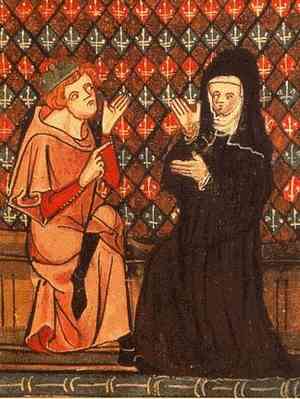 Abelard & Heloise Source: Wikipedia |
|
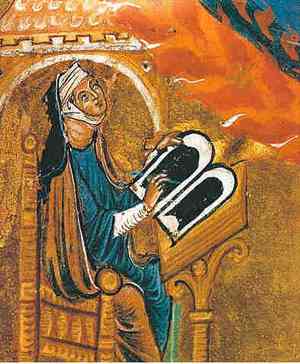 Hildegard Von Bingen Source: Science 2.0 |
Born circa 1098 in Germany, (Saint)
Hildegard of Bingen
is thought to have been placed in the care of Jutta, daughter of Count
Stephan II of Sponheim, at age eight. In 1112 she and Jutta entered the
Benedictine monastery at Disibodenberg, she fourteen. Upon Jutta's death in
1136 Hildegaard became magistra of the nunnery until founding her own in
1150 in Rupertsberg. A second monastery followed at Eibingen in 1165. As
Hildegard was
a mystic, before we advance too far it is well to regard the intellectual,
philosophical and metaphysical backdrop to her musical world in addition the
Church. We refer once again to the ancient Greeks, whose influence will be a
major thread in the development of music for centuries to come. Pythagoras
of Samos [b c 570 BC *]
found harmony in the cosmos via
mathematics and his music of the spheres or, musica universalis
[*],
applied to the concept of celestial orbs. Pythagoras' notion, or varieties similar such as Hildegard's, have been
seriously examined ever since. In far away lands the sacred sound called
Om
was presented in the Hindu 'Upanishads' sometime between 800 and 300 BC.
Farther off in China music would necessarily interweave with Qi (or Ch'i: 1,
2,
3).
As for the spiritual ramifications of a roaring sun in celestial
symphony with other astronomical bodies, I don't know, not so easy to hear
as a heartbeat. Yet the
physical and psychological affects of pitch, tonality vibration and frequency
have been no small study for quite some time, discussed in
relation to present-day string theory as well. But you don't have to know
how it all works to get in touch with a rippling stream, thunder rolling
over the earth or the rhythm of a
crashing tide from your boat rocking like a cradle side to side. If you
listen to your tires slapping time over cracks on the interstate a choir of angels
are bound to come around soon. Hildegard, herself, may have gotten some
harmony in her bones in listening to the wind moan. Hidegard had been subject to visions since a child, yet was reluctant to
speak of them. it wasn't until after founding her monastery in Rupertsberg
that she completed 'Scivias' in 1151/52, a book of 26 visions written over a
period of ten years. Portions of
that work in progress had been read by Pope Eugenius III in 1148. He
concurring that such were divinely inspired, Hildegard now acquired the most
important endorsement of all, that of the Papacy, and began writing on all
manner of subjects in various forms: music for the liturgy, a morality play
titled 'Ordo Virtutum' ('Play of the Virtues'), sermons, a couple of volumes
addressing medicine, an invented language, a Gospel commentary, and a couple
hagiographies. She also left behind nearly four hundred correspondences with
such as emperors and popes. Her second theological volume was 'Liber Vitae Meritorum' ('Book of Life's Merits'), completed sometime between 1158 and
'63, she at Rupertsberg. Her last work before her death was the theological
tome of 1193, 'Liber Divinorum Operum' ('Book of Divine Works'), concerning ten
visions. Hildegard died 17 Sep 1179 and was beautified, but had trouble becoming
an officially recognized saint. She was nevertheless referred to as a saint,
appeared in 'Roman Martyrology' in the latter 16th century and was made a
Doctor of the Church, a rank higher than sainthood, in 2012 by Pope Benedict
XVI. As for music, there was that for the play 'Ordo Virtutum', and a number
of liturgical hymns collected into 'Symphonia Armoniae Celestium
Revelationum'. They were scored in neumes [1,
2,
3,
4,
5] preceding the five-line stave
[1,
2].
Her works would have been sung by nuns or noblewomen.
References for Hildegard: 1,
2,
3,
4,
5,
6,
7,
8.
Authorship: 'The Book of Divine Works' 1193 (CUA Press 2018):
1,
2;
choral works *;
'An Explanation of the Athanasian Creed'
*; 'Lingua Ignota' ('Unknown Language' c 1200)
*;
'Scivias' 1151/52 (Paulist Press 1990)
*;
'Symphonia Armonie Celestium Revelationum ('Symphony of the Harmony of Heavenly Revelations'):
1,
2;
'Symphonia Caritatis: The Cistercian Chants'
*; various *.
Hildegard on recordings: 1,
2,
3,
4,
5,
6,
7.
In soundtracks.
Portrayals in films.
Sheet music.
Further reading: Abbey of St. Hildegard Through the Ages
*;
Pope Benedict XVI *;
International Society of Hildegard von Bingen Studies (ISHBS)
*;
'Symphonia Armonie Celestium Revelationum ('Symphony of the Harmony of Heavenly Revelations')
*.
Bibliographies: 1,
2,
3,
4,
5,
6.
IA.
Other profiles: 1,
2,
3,
4,
5,
6,
7,
8,
9,
10.
References relevant to harmonic world(s):
1,
2,
3,
4,
5,
6,
7,
8,
9,
10,
11.
12,
13,
14.
Hildegard Active 12th century Cappella quartet: Anonymous 4 Cappella quartet: Anonymous 4 1151> Morality play
|
|
|
It isn't known when
Marcabru
was born in Gascony in southwestern France. Dates vary widely from as early
as 1099, but circa 1110 is most commonly seen. Unlike his fellow
troubadours [1,
2,
3,
4,
5,
6] who tended to be
of the aristocratic class, Marcabru is said to have been conceived by a
desperate woman who left him at the doorstep of an anonymous rich man when
he was infant. Howsoever, he eventually entered into the service of
Guillaume X, son of Guillaume IX
d'Aquitaine, the latter usually described as the first known troubadour.
Troubadours were singers of secular songs who wrote their own verses or not
while traveling the countryside or not. For someone with no exact birthdate Marcabru came to great fame, he also often mentioned in histories. He
composed romances, satires, and songs for both the Crusades (Second of 1144) and the
Reconquista (c 801-1492). The Reconquista refers to the reclaiming of the
Iberian peninsula from Islam, beginning with the Battle of Covadonga and
ending with the fall of Granada approaching eight centuries later. The
Crusades, which plumb was Jerusalem, were the
second theater of the struggle of the Roman Church against Islam. Among Marcabru's most popular works was 'Del Lavador' ('The Cleansing Bowl')
written in 1149 for the crusade in Spain, come to be known as 'Lo Vèrs
del Lavador' ('The Cleansing-Bowl Song') [*].
Forty-one of Marcabru's 44 known poems can be read at
Trobar, as well as the poems of
numerous
troubadours. His melodies aren't as extant, there remaining only four
with three possible contrafacta (melodies used by other poets). Those
four melodies are 'Bel m'es quan son li fruich madur', 'Dirai vos senes
doptansa' (c 1138), 'L'autrier jost'una sebissa' and 'Pax in nomine Domini'
(1149). Marcabru died circa 1150. It isn't known how true it may be that
it was his caustic attitude toward lords of Gascony which led them to
arrange his demise. References: 1,
2,
3.
Compositions: 1,
2,
3.
On recordings: 1,
2,
3,
4.
Further reading: Ruth Harvey.
Bibliography: 'Cansos of the Troubadour Marcabru' Mark Taylor (Romania 2000)
*;
'Marcabru and the Spanish Lavador' Ruth Harvey (Forum for Modern Language Studies XXII 1986)
*;
'Ueber den Troubadour Marcabru' Arthur Franz (Marburg 1913)
*.
Other profiles: 1,
2,
3. Marcabru Active 12th century Bel m'es quan son li fruich madur 'I love when the fruits are ripe' Ensemble Tre Fontane Circa 1138 Ensemble Tre Fontane La Reverdie Likely 1149 Song for the Reconquista
|
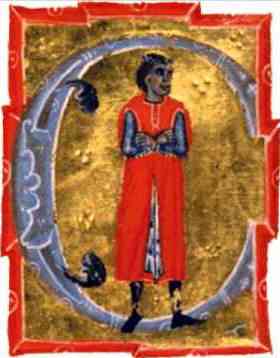 Marcabru Source: Twitter/Marcabru |
|
|
Bernart de Ventadorn Source: Todd Tarantino |
Born circa
1135 in France,
Bernart de Ventadorn
is a good example of the troubadour (itinerant musician).
Troubadours
[1,
2,
3,
4,
5] had begun plying their craft about the cusp of the eleventh
and twelfth centuries and were popular until about mid-fourteenth century. Troubadours were among the earliest instances of secular music apart
from the Church, being poets and singers for whom courtly love
was the large topic. They differed from traveling jugglers and minstrels in
that they sought patronage from kings and queens rather than only lords,
ladies and anyone else with a purse. Indeed, the first troubadour on record
was a count with no need to sing for coins,
Guillaume IX,
born 60 or so years before Bernart. Bernart is exemplary of the canso [*], French at the time for song,
variations of which were canco, canzo, canson and eventually chanson
[1,
2] in
modern French. The canso in Italy was the canto [*], that is, to chant
(sing *).
What it was in other languages matters not here since at Bernart's time
and for a few centuries to come to speak of Europe was to refer en large to
either Italy or France. Norman (French) rule of England since 1066 was
replaced by the even more powerful French family, the Plantagenets, when
Henry II was crowned King of England in 1154 during Ventadorn's youth. The
Plantagenets would reign in England until Henry IV, an English Lancaster, in
1399. In the meantime, born about the same year as Bernart was the poet,
Chrétien de Troyes [*],
the first of the trouvèr(e)s or, troubadours of northern France. The
trouvères would form a genre of love song developed by troubadours in
Occitan (southern France) called the grand chant, grande chanson courtoise
or chanson d'amour
[1,
2,
3].
The trouvere enjoyed a status generally more elevated than that of the
everyday troubadour. It was also during Bernart's lifetime that trobairitz [*]
emerged, that is, female troubadours. Born in Ventadour,
Bernart's authorship is estimated to range from 1147 to 1180. The same
sources have him writing his first poems for the wife of Eble III of Ventadorn,
Marguerite de Turenne, making him about age twelve at the time. Bernart
eventually fell in love with his patroness. But she a viscount's wife, wisdom
persuaded him to leave Ventadour, first for Montluçon, then Toulouse, then England. He was later employed by Count Raimon
V of Toulouse. Bernart later entered a monastery in Dordogne, where he
likely died about 1195. Among works left behind were his love poem of circa
1170, 'Can vei la lauzeta mover' ('When I See the Lark') [1,
2,
3,
4,
5,
6] and 'Uns Chants
Qui Mòu Dins La Cort' ('Uncommon Courtoisie') [*] probably following sometime
later. References: 1,
2.
Compositions.
Recordings of: 1,
2,
3,
4,
5.
IA.
Bibliography: 'Songs of the Troubadours and Trouveres' by Samuel Rosenberg,
Margaret Switten and Gerard Le Vot (Routledge 2013) *.
Other profiles 1,
2. Bernart de Ventadorn Active 12th Century Millenarium C 1150 Alla Francesca C 1150 Maria Lafitte Guitar: Roland Keunings Mediaeval Ensemble Guitar: Roland Keunings |
|
 Cathedral of Notre Dame (Notre-Dame de Reims) Big Dog of Medieval Music |
Born circa
1150 or
1155, likely France,
by the time
Léonin
(probably went by Léo) arrived to this planet the Second Crusade (1147-49)
against Islam threatening regions of the Byzantine Empire, home of Eastern
Orthodoxy,
had only recently come and gone. The Norman (French) line of rule in England that had
begun in 1066 with William the Conqueror and included such as Henry I and
Matilda (Empress Maude) had come and gone as well by 1155, replaced in 1154
by the even more powerful French family that was the Plantagenets. Swedes
had converted from Viking marauding to Roman Catholicism. A couple centuries
earlier Eastern
Catholicism had made its way from Constantinople to Novgorod in 866/867. By Leonin's time Eastern Orthodoxy in Russia had designs on Finland just as did
the Roman Church in Sweden which Fins called Ruotsi (Russia) [*].
As for Leonin, he is an apt example of
early ars antiqua or, European music
from the latter 12th through 13th century [*].
Leonin also applied himself to
the Gregorian chant [*] upon a couple centuries of prior development. The
Gregorian chant has long been popularly credited to Pope Gregory I, who held
the papal seat from 590 to 604. Developed itself out of the plainchant or plainsong
that accompanied Christian rites from the begin
[*], scholars believe the actual origins of the
Gregorian chant to have been around 900, three centuries after Gregory I, emerging from a combination of the
Carolingian and Gallican Roman chant with a stronger French than Italian
heritage. As for Léonin, though polyphony
[*]
would be banned from the liturgy for a time in Rome in 1322 by Pope John
XXII as not
solemn enough for sacred music, in Paris it became an early branch of study at the Notre Dame
[*] School of Polyphony
[1,
2]
where Leonin was employed since its inception. Leonin was instrumental in the development of the
motet (from "mot" that is French for "word"
*) from out of the clausula (polyphonic song: two or more
voices *).
The motet was a major step along the path of counterpoint first introduced
in the latter 9th century in 'Musica Enchiriadis' by an anonymous French
author. Tin Pan Alley sold a lot of sheet music centuries later due to
contributions to notation by Léonin at Notre Dame, he devising a system to
convey meter and rhythm. Léonin lived during the emergence of Gothic
architecture. To the left is a photo of the Cathedral de Notre Dame where
Léonin would have worked during the early phases of its construction begun
in 1163 during the reign of Louis VII and completed circa 1300). Notre Dame
had been built in association w the University of Paris [1,
2] emerging about
1150 AD (la Sarbonne [*] not founded until 1297). There had been teaching
across the Channel at Oxford University [1,
2,
3,
4] since circa 1100. To the right
is a 12th century painting of a lute player in Spain. As significant to
medieval music as Notre Dame was, when it came to musical instruments the
lute [1,
2,
3,
4,
5] reigned supreme. Developed in Mesopotamia
about 3100 BC and
introduced to Europe via the Arabian
oud, the later Renaissance without
the lute would have been like rock n roll without guitar. Léonin's death is
estimated in
1201 or 1210. Some think he is identical to the the poet, Leonius [*].
References: 1,
2.
Recordings of: 1,
2,
3,
4,
5.
Sheet music.
Other profiles: 1,
2,
3.
Léonin Active 12th Century David Munrow Director: Steven Sven Olbash Album Ensemble Organum
|
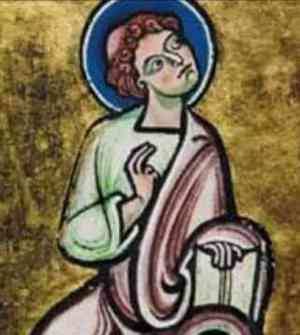 Leonin Source: Geni 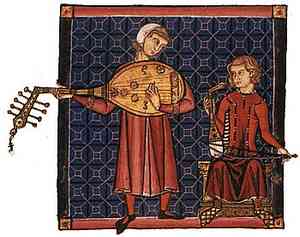 12th Century Lute Player Source: Musicologie |
| Flourishing
circa 1200 in France,
Pérotin
the Great belonged to the Notre Dame [*] School of Polyphony
[1,
2]
in Paris like his mentor,
Léonin. Perotin's birthdate itself isn't
known, estimated c 1155 at Discogs, c 1155/60 per Wikipedia.
Though Pérotin may have been relatively close to the same age as Léonin
the latter was his teacher, both of them arriving in the period
known in scholarship as ars antiqua
[*]
stretching from the latter 12th through 13th century. Perotin expanded the 'Magnus Liber Organi' ('Great Book of
Organum') [1,
2] that was a compilation of polyphonic compositions applied to
the liturgical plainchant begun circa 1170 by
Léonin. Plainchant melodies for two or more voices
were at that time called organum or, harmonic symphoniae.
Pérotin distinguished himself from Léonin largely by his use of tenor amidst multiple (three and four) voices.
Though the 'Great Book of Organum'
was used often by the Church, it isn't
known when either Léonin or Pérotin died. Given a date c 1200/05 at Wikipedia,
Perotin is
also thought to have been alive in
1220, perhaps living to as late as c 1230 [Discogs] or c 1238.
He may have lived long enough to be an elder contemporary of Giacomo da Lentini
born c 1210 [*].
Lentini is thought to have arranged the first sonnets in
the early 13th century in Palermo, Italy, among the first of which was 'Io
m'aggio posto in core a Dio servire' on an unknown date *.
He was also head of the Sicilian School of poetry under Frederick II, which
may begun gathering as early as 1230.
References: 1,
2.
Compositions: 1,
2.
Recordings of: 1,
2,
3,
4,
5.
IA: 1,
2.
Other profiles: 1,
2,
3,
4. Pérotin Active circa 1200 Alleluia Nativitas 1200 The Hilliard Ensemble Beata Viscera 1200 The Hilliard Ensemble Mors (Death) 1200 Chronos Vocal Ensemble Organum Triplum Chronos Vocal Ensemble Sederunt Principes 1199 The Hilliard Ensemble Veni Creator Spiritus The Hilliard Ensemble Viderunt Omnes 1198 The Hilliard Ensemble |
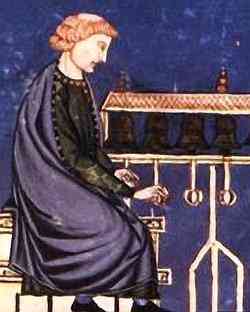 Pérotin Source: Classical Archives |
|
| Born circa
1300,
Guillaume de Machaut
arrived to a world that had recently been through several Crusades with
Christians eventually expelled from the Holy Land come Muslim victories in
Tripoli in 1289 and Acre in 1291. In 1299 Osman I formed what would become
the Ottoman Empire to carve away the Byzantine Empire which would see its
final days in the fall of Constantinople in 1453. Machaut was a child when
Clement V moved the seat of the papacy from Rome to Avignon, France, in
1309, then abolished the Order of the Knights Templar in 1312, burning its
grand master, Jacques de Molay, at the stake in 1314. The Church then sent
its first missionary of good news to India in 1321, the Dominican monk,
Jordanus. It was also during Machaut's lifetime that the black death (bubonic plague) took 75 to 200
million lives along trade routes of Eurasia between 1346 and 1353 [*]. As for
music, Machaut is a fundamental example of ars nova
or, French music during the 14th century. Machaut was
both a composer of sacred music and a secular poet. His repertoire included
rearrangements of traditional troubadour
[1,
2,
3,
4,
5]
melodies. He wrote numerous
motets [1,
2], the earliest form of polyphony developed by
Léonin at Notre Dame in the latter 12th
century. Machaut prolifically applied himself to a broad range of musical
and poetic forms from ballades [*] and
lais [1,
2,
3,
4,
5] to
virilais [1,
2] and the popular
rondeau [1,
2,
3].
He may have completed his choral work, 'Messe de Nostre Dame'
[1,
2,
3,
4,
5,
6], sometime between 1360 and
'65. The 'Messe de Nostre Dame' was the earliest complete setting of the Ordinary of the Mass
[1,
2,
3]
attributable to a single composer. Thus to mention lends opportunity to
regard that of essence to music in Europe was the Catholic Mass which
central rite and concept were presentation of the Eucharist. Mass (Latin: "missa") was
observed by the Eastern Orthodox Church as well. The observance of Mass w
plainchant had been a practice of the Church from the begin, come to involve
reading from scripture followed by congregational response. The liturgy of
the Mass is further divided into the Ordinary of texts unchanging and the
Proper of texts that alter. The complete Mass of the Ordinary has six
sections addressed by Machaut: the Kyrie, Gloria, Credo, Sanctus, Agnus Dei
and Ite Missa Est (dismissal). Machaut had begun serving as
secretary to King John I of Bohemia as a young man in 1323, a position he retained until
John's death in 1346, after which he entered the service of various other
royals, meanwhile surviving the Black Death which had plagued Eurasia from 1346
to 1353. Machaut had assumed his
first position as a canon in the Church in 1330. But as a poet he largely
wrote as to courtly love and narratives. He is known to have written about
400 poems, the larger portion of them ballades. By the time Machaut
died in 1377 he had established himself as the most significant French
composer of his century, and joined Chaucer and Petrarch, his
contemporaries, in regard as a poet. The years of his major musical activity
are estimated between 1340 and 1370.
References for Machaut: 1,
2,
3,
4.
Compositions: 1,
2,
3,
4,
5,
6.
Recordings of: 1,
2,
3,
4,
5.
IA.
Further reading: 'Guillaume de Machaut: Musician and Poet' by Sharon Pearcy (Eastern Illinois U 1999)
*;
'Rondeaux, Virelais and Ballades in French 13th-Century Song' by Willi Apel (Journal of the American Musicological Society 1954)
*.
Bibliography: 'An Author's Role in Fourteenth Century Book Production' by Sarah Jane Williams (Romania 1969)
*;
'A Companion to Guillaume de Machaut' by Deborah McGrady-Jennifer Bain (BRILL 2012)
*;
'Guillaume de Machaut and Reims: Context and Meaning in His Musical Works' by Anne Walters Robertson (Cambridge U Press 2002)
*;
'Guillaume de Machaut: Secretary, Poet, Musician' by Elizabeth Eva Leach (Arts & Humanities Research Council 2011);
extensive.
Other profiles: 1,
2,
3.
References for the Catholic Mass: 1,
2,
3;
Eucharist *;
music of: 1,
2,
3. Guillaume de Machaut De Fortune me doi pleindre et loer 'Ballad 23 1350 Ensemble Musica Nova Douce Dame Jolie 1346 Annwn Doulz Viaire Gracieus The Ensemble Gilles Binchois Je vivroie liement The Ensemble Gilles Binchois Je vivroie liement/Liement me deport Falsobordone Le Jugement du Roi de Navarre The Ensemble Gilles Binchois Messe de Nostre Dame 1364 The Ensemble Gilles Binchois Puis qu'en oubli The Oxford Camerata Quant je sui mis au retour (Virelai 13) La harpe de melodie Tels rit au main qui au soir pleure Complainte Ensemble Project Ars Nova
|
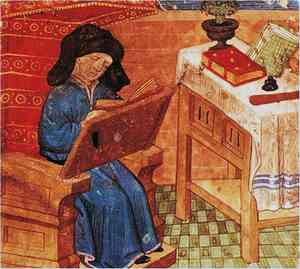 Guillaume de Machaut Source: Centro Studi Europeo |
|
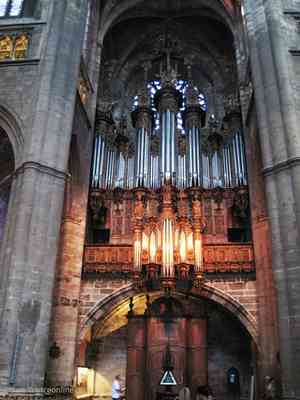 14th Century Organ Cathedral de Rodez Source: Travel France |
Likely born
in Florence, Italy, circa 1335,
Francesco Landini
was Southern Europe's reply to
Machaut in France a generation or so
earlier. The years of his major musical activity between about 1360 and
1397, Landini is a prime example of the Trecento [1,
2,
3] period, that is, the
emergence of the Renaissance in the latter 14th century w the Renaissance
generally understood to embrace the 15th and 16th centuries. The term
"Renaissance" didn't arrive to common usage until 1858 when it was coined by
French historian, Jules Michelet. The term was engraved for all time in 1860
upon the publication of Jacob Burckhardt's tome, 'The Civilization of the
Renaissance in Italy'. Landini's
father was a painter in Giotto's school. Born blind, Landini was a composer,
poet and singer. A multi-instrumentalist, he favored the lute and organ. Like Machaut, his slightly earlier contemporary in France, Landini's musical production was mixed between the
sacred and the secular. Like Machaut, he applied himself to polyphony via
the French motet. Another
form of polyphony with which Landini played was the secular caccia
[1,
2] which translates
to "hunting" in Italiano, "chace" in French (modern "chasse") and "catch" in
English. Hunting applied twofold to cacce (pl), the first in terms of
musical imitation ("chasing") between two instruments or voices, the second
in that numerous cacce addressed fishing or hunting sung as ballate or
madrigals. Well here to cite the Trecento madrigal at the avant of the
Renaissance madrigal.
Though Landini composed largely secular music he had become employed as a Church organist in 1361. No images are found of the few cathedral
organs Landini helped build,
but as the lute was to secular music so was the organ to the Church, thus well to here mention the pipe organ
before we get too far along in this history. Needful then to return again to the Greeks,
one of whom was living in Alexandria, Egypt, when he
invented the water organ, the so-called hydraulis, sometime during his life
stretching from 285 to 222 BC. The organ is basically a set of pipes with a
mechanical wind supply operated by a keyboard. The instrument continued
onward through Roman culture to disappear upon the fade of Rome. The pipe
organ continued, however, in the Eastern Roman Empire (Byzantium)
centered in Constantinople in 330 AD. It was reintroduced to Europe in 757
AD as a gift from Emperor Constantine V to Pippin the Short of the Franks. The
image to the left shows the organ at the Cathedral de Rodez in France as it
would have appeared during
the latter 14th century contemporaneous with Landini. The oldest playable
organ has pipes dating since 1435 at the Basilica of Valère in Sion,
Switzerland. As indicated, pipe organs can be huge, one five stories high,
another with more than 10,000 pipes. Cathedral architecture, art, the Church
organ, stained glass windows,
Latin, all added up to spectacle giving the masses
something to do while drawing them together in common, amassing at the Mass. As an improvement on the more
brutal Roman coliseum games one could think the human race was maturing.
As for Landini, the image to the
right shows him with a miniature or, portative, organ. Images of
musicians playing portative organs appear in illuminated manuscripts as early as
circa 1250. By the time of
his death in 1397, Landini had established himself as Italy's preeminent
composer of the 14th century, though in poetry that distinction would remain
with Dante Alighieri who preceded him by some seventy years, writing his
'Divine Comedy' during the early 14th century prior to Landini's birth.
References for Landini: 1,
2,
3,
4,
5.
Compositions: 1,
2,
3,
4.
Recordings of: 1,
2,
3,
4,
5,
6.
IA.
Other profiles: 1,
2,
3.
References for the organ: 1,
2,
3;
pipe organ: 1,
2,
3;
portative organ: 1,
2,
3,
4,
5;
organs of note: Great Stalacpipe;
Hazel Wright;
Wanamaker: 1,
2;
various.
Francesco Landini Adiu, adiu dous dame 1350 Ensemble Alla Francesca La Bionda Treçça 1350 Ensemble Alla Francesca Cara Mia Donna 1350 Donna, s'i'' t'o fallito 1350 Studio der Frühen Musik A Laurel for Landini The Gothic Voices Deh,, Dimmi Tu 1350 The Lumina Vocal Ensemble Ecco la Primavera 1350 The Waverly Consort Guarda una Volta 1350 The Gothic Voices I' Priego Amor 1350 Sylvain Bergeron/ Margaret Folkemer Jennifer Grout/ Laura Osterlund Lasso! Di donna vana inamorato 1350 Ensemble Alla Francesca Musica Son/Già Furon/Ciascun Vuol The Gothic Voices Non avra ma' pieta questa mia Donna 1350 The Ensemble Unicorn |
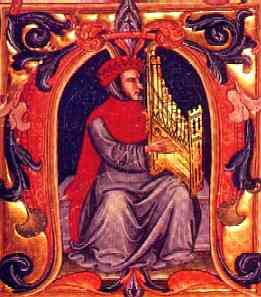 Francesco Landini Source: Wikipedia |
| Born about
1390 in Bedfordshire, England,
John Dunstaple
well represents late medieval and early Renaissance across the channel from
the Continent, his years of major musical activity, 1415 to 1453, placing
him in the Ars Nova period. Though it's unlikely that Dunstaple ever served the Church in
any clerical capacity he was a composer of largely sacred music including
motets, here a sample of
unidentified date. Dunstaple
was a well-educated man, especially in astronomy, astrology and mathematics.
He was also richly propertied in multiple locations. He may have served for
a period in France for John of Lancaster, then the Governor of Normandy from
1429 to 1435. He also found patronage in the dowager, Queen Joan, then the
Duke of Gloucester in 1437. Albeit Dunstaple's output was prodigious, and
his prestige on the continent huge, the ravages of history have left only
about fifty extant works by him. Dunstaple died on 24 Dec 1453.
References: 1,
2,
3,
4,
5.
Compositions: 1,
2,
3; choral
*.
Recordings of: 1,
2,
3,
4,
5,
6,
7.
Further reading 1,
2.
Other profiles: 1,
2,
3. John Dunstaple Beata Mater C 1410-53 Nesciens Mater Specialis Virgo C 1410-53 The Orlando Consort Quam Pulcra Es C 1410-53 The Hilliard Ensemble Salve Regina Misericordiae C 1410-53 The Hilliard Ensemble Salve Scema Sanctitatis C 1410-53 Collegium Aureum & the Pro Cantione Antiqua Sancta Maria C 1410-53 Veni Sancte Spiritus/Veni Creator C 1410-53 The Hilliard Ensemble |
||
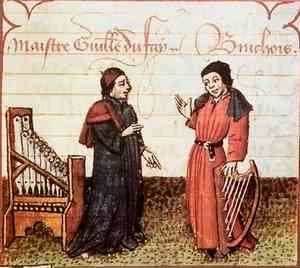 Guillaume DuFay w Gilles Binchois Source: Wikipedia  Burgundy Origin of the Burgundian School which would soon expand north into the greater Franco-Flemish School. |
Born in
Beersel near Brussels (Belgium) about 1397,
Guillaume Dufay
was the illegitimate son of an unknown priest. DuFay spent his entire life
from childhood onward
in Cambrai in northern France, minus extended
periods of travel. At only age sixteen he was made chaplain at St. Géry by
benefice. In 1420 he found patronage with the Malatesta family in
Pesaro, Italy. By hook and crook he had become a priest in Bologna by 1428, the
same year he went to Rome to become a member and master in the Papal Choir.
About 1437 he returned (yet again) to Cambrai, where some time between then
and 1446 he took a law degree. DuFay also found patronage with the Este
family in Ferrara during the thirties. During the forties he entered into
the service of the Duke of Burgundy, becoming a canon in Mons in 1446 as
well. By the time of his passing on 27 Nov 1474 DuFay had become the most
influential composer in Europe, notably for our purposes here in association with
the Burgundian School [1,
2,
3,
4] expressive of the early Renaissance period.
DuFay's principle musical activity had covered the years of 1430 to 1474
including 87 motets, 66 French or Italian chansons and 8 complete masses.
References: 1,
2,
3,
4,
5,
6,
7.
Compositions *.
Recordings of: 1,
2,
3,
4,
5.
In soundtracks *.
IA.
Sheet music: 1,
2.
Other profiles:
1,
2,
3.
Per DuFay's settings for the 'Magnificat' below, the 'Magnificat'
[1,
2,
3,
4] is a
canticle, that is, a hymn which lyrics are borrowed from the Bible. The 'Magnificat'
quotes Mary, Mother of Jesus, in 'Luke' 1:46-55, which text will be set to music
countless times through centuries to come to the present day. In the Eastern
Orthodox Church 'Magnificat' is known as the 'Ninth Ode' or, 'Song of the Theotokos' [1,
2]. Guillaume DuFay Adieu ces bons vins de Lannoys 1426 Ave Maris Stella Ensemble: Pomerium Flos Florum 1430 Vokalensemble Pro Musica & the Instrumental Ensemble J'ai mis mon cuer Ensemble Unicorn Magnificat 1 & 2 La Capella Reial De Catalunya Miserere Nostri/Vexilla Regis Missa L'Homme Armé 1460 Oxford Camerata Nuper Rosarum Flores 1436 Capella Antiqua München Se la face ay pale, la cause est amer Studio der Frühen Musik Vergine Bella Mignarda & Ron Andrico |
|
| Born about
1400 in Netherlands,
Gilles Binchois
(Gilles de Binch) was a composer of the Burgundian School [1,
2,
3,
4]
in France, wellspring of the early musical Renaissance, he about the same
age
Guillaume Dufay. The
Burgundian School which was the early phase of the greater Franco-Flemish
School [*]
emerging about 1420 to supply music to Europe throughout the Renaissance.
The Proto-Renaissance had emerged in Italian art in the latter 13th century
(exemplar in Giotto), beginning what is called the "long" Renaissance of
1300-1600 with the French Renaissance arriving in the latter 14th century.
The Early Renaissance covers the years 1425 to 1495, Botticelli's 'Birth of
Venus' painted c 1482-86. The High Renaissance of 1495 to 1520 wrought such
as Michelangelo's 'Pietà' in 1498–99 and Leonardo da Vinci's 'Mona Lisa' c
1503-07. Mannerism is the Renaissance extended to 1600. Though the
Renaissance in art and architecture was for the greater part an Italian
spectacle, in music it was a largely Flemish-French affair.
By the time of Binchois' own birth the French House of Plantagenet across
the Channel in England had become the British House of Lancaster, to remain
so throughout Binchois' life, to become York in 1471, Tudor in 1485. It was
during Binchois' lifetime that Pope Nicholas V began to build the Vatican
Library w ancient Greek and Latin texts in 1447. Binchois would be alive
when the Muslim Ottoman Empire removed Eastern Orthodoxy from
Constantinople, the latter falling in 1453 to become Istanbul. Records find Binchois' earliest activity to be that of a church organist in
Mons in 1419. He is thought to have served as a soldier until joining the
court chapel of Burgundy and there becoming a singer among 18 others
employed by the court. The majority of Binchois' songs were rondeaux
concerning chivalry and love. Long years of service to the Burgundian court
enabled Binchois to eventually retire in
Soignies on
a nice pension. His years of principle musical activity had been from 1430
to his death on 20 Sep 1460. References for Binchois: 1,
2,
3,
4.
Compositions: 1,
2,
3; choral
*.
Recordings of: 1,
2,
3,
4.
Sheet music *.
Further reading: 'The Religious Music of Gilles Binchois' by
Joan Boucher (Boston U 1963).
References for the Renaissance: England;
France;
Germany;
High;
Italy;
Poland;
Scotland;
Spain: 1,
2,
3;
Venice. Gilles Binchois Adieu, adieu, mon joileux souvenir Lena Susanne Norin, Randall Cook & Susanne Ansorg Amours Mercy Ensemble Gilles Binchois/Dominique Vellard Gloria, laus et honor Ensemble Gilles Binchois/Dominique Vellard Les tres doulx yeux Ensemble Graindelavoix/Björn Schmelzer Mon Cuer Chante Clemencic Consort/Réne Clemencic Triste plaisir et douleureuse joye Lena Susanne Norin, Randall Cook & Susanne Ansorg Vostre tres doulx regart Ensemble Gilles Binchois/Dominique Vellard |
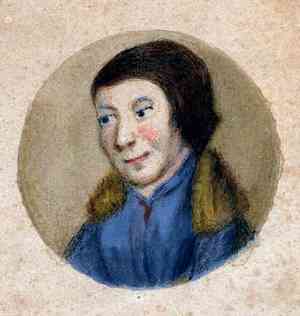 Gilles Binchois Source: Wikipedia |
|
| Born circa
1410 (perhaps as late as 1430) in Belgium,
Johannes Ockeghem
(Jean) was a composer of the Franco-Flemish School [*]
that was the greater expansion of the Burgundian School
[1,
2,
3,
4] out of which the musical Renaissance
occurred. Ockeghem composed motets, masses and secular chansons (songs). Like many medieval composers, Ockeghem likely began his career as
either a choir singer or choirmaster. The first record of his employment
dates from 1433, in which he is a singer in the choir of the
Onze-Lieve-Vrouwe cathedral in Antwerp. Though likely under the direction of
composer, Johannes Pullois (Pullois' first employment at the
Onze-Lieve-Vrouwe cathedral that same year), Ockeghem would eventually come
to greater renown than his choirmaster. Ockeghem worked for both Church (as
a treasurer for a time) and Court. He began in the latter capacity in 1446
as a singer for Charles I, Duke of Bourbon. Ockeghem also served King
Charles VII and King Louis XI (nor only as a musician, known to have
traveled to Spain in 1470 on a diplomatic mission). Also a music teacher,
Ockeghem held posts at Notre Dame and St. Benoit. Extant works by Ockeghem
barely exceed forty. Though the principle period of Ockeghem's musical
activity may stretch from 1440 to his death in 1497, his relatively small
compositional legacy may have been due to a career otherwise occupied,
concerning which little is known. Leaving behind only 10 motets, 13 or 14
masses and 20 chansons (songs), he nevertheless came to rather notable
prestige before his death in Tours, France, on 6 Feb 1497.
References: 1,
2,
3,
4,
5,
6.
Recordings of: 1,
2,
3,
4,
5;
masses by the Clerks' Group *.
Audio: 1,
2.
Sheet music *.
Bibliography: 'Ockeghem: Great Religious Composers' by Ernst Krenek (Sheed & Ward 1953);
various.
Other profiles: 1,
2,
3,
4.
Johannes Ockeghem Deo Gratias 1497 Huelgas Ensemble Déploration sur la mort de Binchois 1460 Graindelavoix/Björn Schmelzer Ma Maitresse Circa 1455 Capilla Flamenca Missa: Au Travail Suis Circa 1470 The Tallis Scholars Missa: L'Homme Armé Circa 1455 Ensemble Voix Fort Cleres Missa: Prolationum (Ordinary of the Mass) Circa 1470 Cappella Nova Quant de vous seul je pers la veue Circa 1470 Ferrara Ensemble Qu'es mi vida, preguntais La Capella Reial de Cataluny Requiem Aeternam The Hilliard Ensemble Salve Regina 1498 |
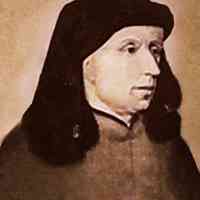 Johannes Ockeghem Source: Wikipedia |
|
| Born circa
1430 in the Netherlands, perhaps Pas-de-Calais in northern France, like
Binchois above,
Antoine
Busnois was another composer of the Burgundian School
[1,
2,
3,
4]
and contributor to the musical Renaissance. The principle years of his
musical activity probably stretched from 1450 to the end of his life. Though Busnois wrote sacred music such as
motets, masses and Magnificats, the larger portion of his work consisted of
sixty surviving secular chansons (songs), mainly rondeaux and some bergerettes.
The bergerette is a virilai of only one stanza. The virilai is among the
three "fixed forms" along with ballades and rondeaux that had long since
become standard by the time of Busnois. Busnois was an aristocrat who by 1461 had become a chaplain in
Tours, then a subdeacon in 1465. He next taught music for about a year in
Poitiers before entering into the service of Duke Charles the Bold in
Burgundy. Busnois served Charles not only at court but on military
expeditions as well, surviving the Battle of Nancy in which Charles was
killed and Burgundy permanently humbled in 1477. Busnois continued with the
Burgundian Court until 1482, the remaining ten years of his life unknown.
References: 1,
2,
3,
4,
5.
Compositions: 1,
2; choral
*.
Recordings of: 1,
2,
3.
Audio at BBC.
Scores.
IA.
Further reading: 'Parisian Nobles...Medieval Song' by Paula Higgins;
HMR Project. Antoine Busnois Alleluya Amours nous traitte honnestement Capella Sancti Michaelis Anima mea liquefacta est 1492 Capella Sancti Michaelis Anthoni usque limina Capella Sancti Michaelis A Vous sans autre Ernst Stolz Fortuna Desperata 1470 Pizzazz Handbell Trio Gaude Caelestis Domina The Orlando Consort Je ne puis vivre ainsi Pomerium/Blachly |
 Manuscript of Busnois' Missa, O Crux Lignum Source: Wikipedia |
|
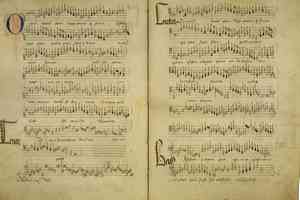 Score to Compère's Omnium Bonorum Plena Source: Wikipedia |
Born circa
1445, possibly in Belgium,
Loyset Compère was among the
many Franco-Flemish (Netherlandish) composers who helped occasion the
Renaissance in music. Educated in the Burgundian style, Compère composed
largely motets and chansons. He also completed two Masses ('Alles regrets' /
'L’homme armé') and four Magnificats. His earliest-known composition is the
Marian motet, 'Omnium Bonorum Plena', which may have been written for the
dedication of the Cambrai Cathedral in northern France on 2 July 1472.
Compère's earliest known employment was in the
seventies at the chapel of Duke Galeazzo Maria Sforza in Milan. This was his
first brief period in Italy. Upon the
murder of Sforza in December 1476 Compère probably returned to France where
he may have served at the Court of Duke Jean II of Bourbon at some time
during the eighties. Jean II died in 1488, the year that Compère commenced
service to the Court of King Charles VIII. His second brief period in Italy
arrived in 1495 when he accompanied Charles' invasion of the politically
divided country in a bid for Naples upon the death of Ferdinand I (King of
Naples) in January 1494. Charles died in 1498, the year thah Compère was
also at some time employed at the Church at Cambrai. He was at St. Pierre in
Douai from about 1500 to 1504, a provost the latter couple of years. He was
last employed at the Collegiate Church in Saint-Quentin where
he died on 16 August 1518.
References: 1,
2.
Compositions: 1,
2,
3.
Recordings of: 1,
2,
3.
Scores.
IA.
Other profiles: 1,
2,
3,
4. Loyset Compère Alons Fere Nos Barbes 1480 The Orlando Consort Ave Maria Joli Cuer Crux Triumphans 1490 Ensemble Cantus Figuratus Gaude Prole Regio ('Rejoice, Pearls of Virgins') 1490 Capella Sancti Michaelis Le grant désir d'aymer me tient Pub 1502 Le Banquet du Roy Je suis amie du fourrier Pub 1502 Capella Sancti Michaelis Magnificat Capella Sancti Michaelis Missa Galeazescha: Ad Elevationem Ensemble Pian & Forte w Gabriele Cassone Missa Galeazescha: Virginis Mariae Laudis Director: Paolo Da Col Nous sommes de l'ordre de Saint Babouyn Ensemble Clément Janequin/Dominique Visse Omnium Bonorum Plena Orlando Consort Scaramella fa la galla 1494 Capella Sancti Michaelis Vous me faites morir Capella Sancti Michaelis |
|
| Born circa
1445 in Belgium,
Hayne van Ghizeghem
was a Burgundian School Renaissance composer assigned to a music teacher by
Count Charles (later the Bold). The earliest employment records find him
under Charles in 1467 as a singer, as well as valet. Hayne served Charles
not only as a composer, but as a soldier by 1465 as well. He was once
thought to have been killed in battle at the Siege of Beauvais in 1472. But
he is now thought to have lived as late as 1497. Hayne apparently
had much else to do in the service of warring Charles. There are only
perhaps twenty works attributable to him, of which only eleven are fairly
certain. Like other composers and poets of his century, the rondeau was Van
Ghizeghem's favored discipline in the simple chansons he composed.
References: 1,
2,
3.
Compositions: 1,
2.
Recordings of: 1,
2,
3,
4.
Scores: 1,
2. Hayne van Ghizeghem De tous biens plaine Hespèrion XX/Jordi Savall Gentilz Galans Asteria (Sylvia Rhyne & Eric Redlinger) Amors Amors Jan DeGaetani |
||
 Score of Agricola's Fortem Virili Source: Wikimedia Commons |
Born
Alexander Ackerman in Ghent, Belgium, in 1445 or '46,
Alexander Agricola was a
composer of motets (sacred) and chansons (secular) of the Franco-Flemish school [*].
Principle musical activity fell between about 1475 and his death in 1506
placing him among numerous Flemish composers of the musical Renaissance in
Europe. Agricola owns the distinction of having been a
viol player who also
composed numerous pieces to include the instrument. Earliest
records discover him a singer for Duke Sforza in Milan, Italy, in 1471. He
is thought to have been hired by Lorenzo de' Medici in 1474. From that time
onward little is known about Agricola but that he divided his time between
France, Naples and the Low Countries (Belgium, Netherlands) such that by the
last decade of the century he was a composer in demand throughout Europe.
With masses included among his compositions, during his latter years
Agricola served under Philip (Duke of Burgundy and King of Castile House of
Habsburg). He died
of bubonic plague on 15 August 1506 while visiting Valladolid, Spain. References: 1,
2,
3.
Compositions: 1,
2; choral
*.
Recordings of: 1,
2,
3,
4.
Scores.
Audio at BBC.
Other profiles: 1,
2,
3. Alexander Agricola Adieu M'Amour Unicorn Ensemble A la Mignonnede Fortunee Unicorn Ensemble Ay Je Rien Fet Cecus Non judicat de Coloribus Graindelavoix De tous bien plaine Capella Sancti Michaelis Fortunaa Desperata Graindelavoix Et Qui laa Dira Unicorn Ensemble L'Eure Est Venue In Mijnen Sin (To My Delight) 1480 The Egidius Quartet Je n'ay deuil Fretwork Magnificat Capella Sancti Michaelis Soit Loing Ou Pres |
|
| Born in
Flanders in 1450,
Heinrich Isaac
emphasizes the great significance of the Dutch
(Netherlandish, Franco-Flemish) in the Renaissance of music in Europe. As
among the more important composers of the Renaissance he is distinguished in
ways not of which can be here addressed. It comes to mind, however, that before the fifteenth century music was composed
mainly for voice, instruments having a supportive role too minor for much
attention. Isaac wasn't the
first to write textless music suitable for instruments, but w Isaac
composition emerges for chamber ensembles [1,
2,
3,
4] in particular. Chamber music since
Isaac generally consists of two to seven instruments. It was called
"chamber" simply because it was played in small spaces for select audiences
rather than staged in cathedrals for the masses. In Isaac's time a chamber
ensemble would have included such as the recorder
or
viol. Along w instrumentals Isaac
composed sacred motets and masses as well as songs (chansons) in multiple languages.
Isaac may have been composing by 1470 (age 20) but his
earliest known employment wasn't until 1484 as a singer for Duke Sigismund of
Austria. The next year finds him in Florence, where he sang at the church of
Santa Maria del Fiore. He was employed at the Santissima Annunziata from
1491-93. Lorenzo
de' Medici summoned him to Florence in 1884. Upon Lorenzo's death on 8 April 1492 Isaac set music
to Poliziano's 'Quis dabit capiti meo aquam'. Isaac is thought to have performed at the coronation
of Pope Alexander VI in 1492. In 1496 he left Florence upon securing appointment as court
composer for Holy Roman Emperor Maximilian I in Vienna. Of note during his
time w
Maximilian was the 'Choralis Constantinus' [1,
2,
3,
4,
5] the first set of which was commissioned for the Constance
Cathedral (Konstanz Minster) in Germany in 1508. The complete 'Choralis Constantinus'
is a collection of above 375 Gregorian chants written as motets. Gregorian
chants, appearing about 900 AD, were originally intended for single voice.
Motets were the first form of polyphony to arise in sacred music at Notre
Dame back in the 13th century. One might say "permitted" to arise, as choirs
performing choral works in churches as they are now heard didn't arrive with
early Church music for which only monophony was thought to be sufficiently
sober for sacred meaning. Polyphony had also been employed by secular French
troubadours (12th century) whose subject was more the passions of courtly
love than the Passion of Jesus, something from which to keep sacred music
disassociated. What was an important conceptual concern to the Church in
Italy (a lot of "mono" or "poly" involved in matters spiritual,
philosophical, et al), however, wasn't a thing to the French whose
Léonin had introduced the motet
in the 12th century, further examined by his contemporary at Notre Dame,
Pérotin. Be as may, the 'Choralis
Constantinus' had been completed by Isaac's
Swiss student and copyist, Ludwig Senfl
[1,
2], the latter himself a composer of 240 motets, 7 masses and
262 lieder (songs). Though Senfl died in 1543 Book I of the 'Choralis
Constantinus' saw publishing in Nuremberg in 1550. Books II and III followed
in 1555. Isaac remained in the service of
Maximilian until his death on 26 March 1517, while also traveling variously about
northern Europe and Italy, finally settling in Florence. Upon his passing he
left several hundred compositions, mostly motets, being among the most
prolific composers of the Renaissance. Isaac is also distinguished from
other composers of his period due to his influence in Germany via the
Habsburgs, occasioned by his employment in Austria. The significance of such
is the greater upon noting that Martin Luther may have posted his '95
Theses' on the door of the Wittenberg Cathedral not long after Isaac's death
on 31 October 1517, that to bring about a major upheaval in the music of
Europe, being the official date of the dawn of the Protestant Reformation.
References: 1,
2,
3,
4.
Compositions.
Scores: 1,
2.
Recordings of: 1,
2,
3,
4,
5,
6.
Compilations: 'Henricus Isaac: Nell Tempo di Lorenzo de’ Medici and Maximilan I 1450-1519' by Jordi Savall w Hespèrion XXI & La Capella Reial de Catalunya
(Alia Vox AVSA9922).
Other profiles: 1,
2,
3,
4,
5,
6. Heinrich Isaac A la Battaglia Concerto Palatino Fortuna Desperata Jordi Savall Der Hund Recorders: Julie Braná Jakub Kydlíček Marek Špelina Et qui la dira Ernst Stolz Missa de Apostolis: Gloria The Tallis Scholars Missa de Apostolis: Kyrie The Tallis Scholars Las Rauschen Ensemble Villanella Tota Pulchra Es The Tallis Scholars Innsbruck, Ich muss dich lassen The Capilla Flamenca Resurrexi: Introitus The Ensemble Versus Rorate, caeli Capella Sancti Michaelis Un dì lieto giammai Virgo Pridentissima 1-2 Capella Sancti Michaelis |
||
| Born Josquin
Lebloitte in circa 1450-55 (some sources 1440) in the Duchy of Burgundy (modern Belgium),
like many composers of the Renaissance,
Josquin des Prez
was of the Franco-Flemish school. His actual surname may have been Lebloitte,
des Prez arising of a nickname. He is also referred to as Josquin (Joseph)
Deprés [Catholic Encyclopedia of 1913]. The
musical Renaissance in Europe was largely a Flemish and French affair.
Josquin (as is often called) was among a few who took the developments of
the Burgundian and Franco-Flemish schools south to the Renaissance in Italy. Josquin composed
both sacred and secular music, largely Masses, motets and chansons greatly popular at
the time. Des Prez is thought to have begun his career in music as a
choirboy in Saint-Quentin about 1460. He may have studied counterpoint under
Ockeghem
above. Probably composing seriously about 1475, by 1477 Josquin was a singer for the Duke of Anjou at his chapel in
René. Perhaps as early as 1480 Josquin had acquired the patronage of the
Sforza family, likely in Ferrara, Italy, then Milan. From 1489 to 1495
Josquin was a member of the papal choir in Rome. He likely left the Sforza
family in Milan in 1499, returning to France upon the invasion of northern
Italy by Louis XII that year, imprisoning his Sforza patrons. Church
reformer, Girolamo Savonarola, whom Josquin admired, had been burned at the
stake in Florence the year prior in 1498. Entering into the service of
Louis XII until 1503, Josquin then found employment at the chapel of Duke Ercole I of Ferrara. But as the plague was there erasing lives again, he
left the same year for Condé-sur-l'Escaut at the border of Belgium and
France. He there spent at least some portion of the last couple decades of
his life as a choirmaster and provost. 'Pater Noster/Ave Maria' may have been his last
composition before his passing on 27 August 1521. Of sacred music, eighteen
Masses and eight Mass sections (such as Credos) are now ascribed to him
along with 58 motets. He is credited with 59 secular chansons.
References: 1,
2,
3,
4,
5,
6,
7,
8. Compositions:
1,
2,
3,
4,
5.
Recordings of: 1,
2,
3,
4.
In soundtracks *.
Audio archive *.
Further reading: John Lienhard *;
'Master of the Notes' *.
Other profiles: 1,
2,
3,
4,
5. Josquin des Prez Ave Maria Possibly as early as 1485 Earliest dateable work La Chapelle Royale Philippe Herreweghe El Grillo 1505 David Feldman Eitan Drori David Nortman Elam Rotem Mille Regretz Pub 1533 The Scholars of London Miserere Mei Deus 1503/04 The Hilliard Ensemble Missa: Pange Lingua 1514 Tallis Scholars Nymphes des Bois 1497 Cappella Pratensis Pater Noster The Hilliard Ensemble Qui Habitat 1520 Huelgas Ensemble Stabat Mater Dolorosa 1498 La Chapelle Royale/Philippe Herreweghe |
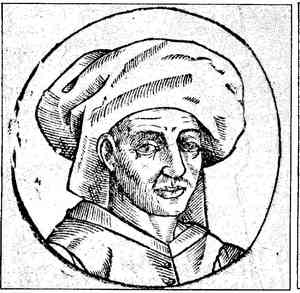 Josquin des Prez Source: HOASM |
|
| Born in 1457
or '58 in Ghent, Belgium,
Jacob Obrecht's
father was employed as a city trumpeter. Of the Dutch (Franco-Flemish)
school, he composed largely masses (30) and motets (28), though wrote secular
chansons as well. His principle years as a composer commencing about 1477
during the European Renaissance, we pass through the first decade of his
career to 1487 when he was commissioned to write the 'Mass for St. Donatian' ('Missa
de Sancto Donatiano') by Adriane de Vos in Bruges, Belgium
[1,
2,
3;
score]. Obrecht worked largely in Flanders until 1487
when he entered into the service of Duke Ercole I
d'Este in Ferrara, Italy, for about half a year [*].
Sometime during or briefly after that visit Obrecht composed his 'Missa
Fortuna Desperata' later published in 1503
[1,
2,
3;
score]. Obrecht's return to
Italy in
1504 would be fatal, he dying in Ferrara in late July of 1505 of bubonic
plague, about
one year before
Agricola of the same cause in Spain. (The Black Death had ravaged Europe 150 years
earlier during the period of
Landini and
Machaut, arriving from
central Asia along the Silk Road. But plague far from disappeared from
Europe only because it had largely run its course of seven years from 1346
to 1353 upon finally reaching Russia. The Death continued to plague Europe
variously until the 19th century. One source has the Black Death devastating
one third of the globe's population, about 150 of 450 million.) One evidence
in Europe of success on Earth was to have one's portrait painted, the image
to the right a small section of a work commissioned by Obrecht in 1496 when
he was 38 years old. References: 1,
2,
3,
4,
5.
Compositions: 1,
2,
3,
4.
Scores.
Recordings of: 1,
2,
3.
Further reading: Gramophone. Other profiles:
1,
2,
3,
4,
5.
Als al de weerelt in vruechden leeft Capella Sancti Michaelis Ave Maris Stella Vox Mousai Women's Choir Beata Es, Maria Capella Sancti Michaelis Meskin Es Hu Daniel Mantey Mille Quingentis 1489 The Clerks' Group Missa: Caput Oxford Camerata Missa de Sancto Donatiano: Gloria 1487 The Cappella Pratensis Parce, Domine Capella Sancti Michaelis Salve Regina a 6 Capilla Flamenca |
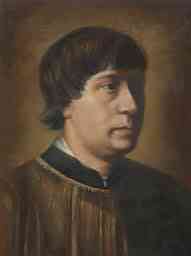 Jacob Obrecht Source: HOASM |
|
| Born Jean de
Hollingue circa 1459 near Boulogne-sur-Mer in northern France,
Jean Mouton's
first employment is thought to have been at the collegiate church in Saint Omer as
both a singer and a teacher. The principle years of his compositional
activity commencing about 1477, he went to Nesle where he was made
choirmaster in 1483, also becoming a priest about that time. By 1501 he was
choirmaster at the cathedral in Amiens, then in Grenoble the next near. In
1503 he entered into the service of Queen Ann of Brittany and King Louis
XII, with which court he remained the rest of his life. Unlike other
Renaissance composers, Mouton traveled little, making only one trip to
Italy, probably in latter 1515, to receive an award from Pope Leo X in
Bologna for masses and motets Mouton had written. Toward the end of his life
he may have assumed
Loyset Compère's position as canon in Saint-Quentin upon
Compère's death in 1518. Mouton there died on 30 Oct 1522. Unlike
a lot of other
Renaissance composers, most of Mouton's work is thought to have survived: 9
Magnificats, 15 masses, 20 chansons (secular) and above 100 motets
(sacred). References: 1,
2,
3.
Compositions: 1,
2,
3.
Scores.
Recordings of: 1,
2,
3,
4.
Other profiles: HMR Project. Jean Mouton Ave Maria Virgo Serena Ensemble Didascalie Celeste Beneficium (Royal 8 G VII) 1514 Capilla Flamenca En venant de Lyon Hodie Christus natus est Gregoriana/Jan Mikušek Nesciens Mater Medici Codex of 1518 Monteverdi Choir/Gardiner Noe, Noe, Psallite Noe Ensemble Clément Janequin/Dominique Visse The Trio Musica Humana Quaeramus cum pastoribus Madregalia and the Pastyme Consort Salva Nos Domine Cappella Nicolai |
||
| Born about
1460 near Chartres,
Antoine Brumel
was yet another of the Franco-Flemish composers who hogged the show during
the European Renaissance, and another who eventually took his talents to
Italy. Brumel composed chansons,
instrumentals and motets, but he is perhaps best regarded for his masses. Principally active as a composer from about 1483,
he is thought to have begun his career as a singer
at Notre Dame de Chartres. From Chartres Brumel moved on to
Geneva, then Laon, until becoming choirmaster at Notre Dame de Paris in
1498. Upon
Jacob Obrecht's death of plague while in service to Alfonso I
d'Este, Duke of Ferrara, Brumel replaced him in 1505. His employment in
Ferrara come to a close in 1510, Brumel then worked in churches in Faenza
and Mantua, the latter where he likely died in 1512/13.
References: 1,
2,
3,
4.
Compositions: 1,
2,
3,
4,
5.
Scores.
Recordings of: 1,
2,
3,
4.
IA.
Other profiles: HMR Project. Antoine Brumel Dies Irae Dies Illa Huelgas Ensemble/Paul Van Nevel Gloria in Excelsis Deo The Tallis Scholars/Peter Phillips Sicut Lilium I Buoni Antichi I Pierre de la Rue The Tallis Scholars/Peter Phillips Lamentations of Jeremiah I Buoni Antichi Mater Patris et filia The Suspicious Cheese Lords Missa: Et Ecce Terrae Motus Circa 1497 Ensemble Clément Janequin Les Sacqueboutiers de Toulouse Missa: A l'ombre d'ung buissonet Daltrocanto/Dario Tabbia Nato Canunt Omnia Blue Heron |
||
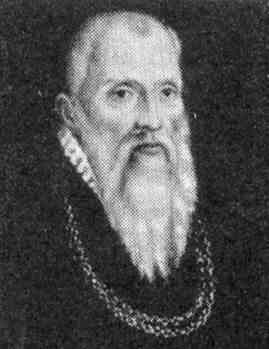 Adrian Willaert Source: HOASM |
Born circa 1490 in Rumbeke, Belgium,
Adrian
Willaert, of the
Franco-Flemish school, was founder of the Venetian school of music during
the Renaissance. Intending to study law in Paris, he switched to music and
was probably composing by 1510. He
visited Rome about 1515 where the papal choir was already singing one of
his songs, thinking it was by
Josquin des Prez. Upon
informing the choir of its error it sang the song not again. Willaert
nevertheless entered into the service of Cardinal Ippolito I d'Este of
Ferrara that same year. Upon the cardinal's death he served Duke Alfonso of
Ferrara until 1525, at which time he went to Milan to work for Ippolito II
d'Este. It was in 1527 that Willaert became maestro di cappella
(choirmaster) of St.
Mark's [*] in Venice, a post he retained until his death on 7 Dec of 1562. The
Republic of Venice had been formed in 697, Paolo Lucio Anafesto its first
Doge ("Duke" *). By Willaert's time it was a major maritime power with
territories stretching as far as Crete and Cyprus along the southwestern seaboard of the
Ottoman Empire. St. Mark's Basilica had begun construction in 828. By the
time of the Renaissance Venetian architecture [*] was among the major features
of Europe. Willaert had been a youth during the heydays of Venetian
painters, Giovanni Bellini, Gentile Bellini and Giorgione. His own close
contemporary was the painter, Titian, possibly born in 1489 only a year
before Willaert. As choirmaster at St. Mark's Willaert developed a reputation such that composers throughout Europe
went to Venice to study under him, hence the Venetian School [*]. Willaert is
credited at least in part for the development of the canzone (secular song
resembling a madrigal) and ricercar(e) (early form of fugue) [1,
2,
3]. But he is
perhaps best regarded for his contributions to the madrigal, a form of
polyphonic song that became highly popular in the 16th century due much Willaert. (The madrigal gradually replaced the fratolla [simply a secular
Italian song] due largely also to Pietro Bembo, an author and editor of
some prestige who pointed to Petrarch as the ideal.) 'Quando Nascesti Amor',
below, is a madrigal. Willaert left behind 8 to 10 masses, above 50 hymns
and psalms, more than 150 motets, some 60 French chansons, above 70
madrigals and 17 ricercares. By the time of his passing on 7 Dec of 1562 Willaert had helped
transform Venice from a musical backwater into one of the major centers of
European music to follow the
Renaissance. References: 1,
2,
3.
Compositions: 1,
2,
3.
Scores.
Recordings of: 1,
2,
3.
IA.
Further reading: Europeana.
Other profiles: 1,
2,
3,
4,
5.
Adrian Willaert Lauda Jerusalem Pub 1550 Currende Choir/Concerto Palatino Ensemble Madonna mia famme bon'offerta Pub 1545 Concerto Scirocco Missa: Christus Resurgens Choir of St. Ignatius O Bene Mio Pub 1542 Accademia degli Imperfetti O Dolce Vita Mia Pub 1545 The King's Singers O Magnum Mysterium Pub 1539 Cappella Marciana Quando Nascesti, Amor Madrigal Pub 1559 Ricercar XIV: Consort Veneto Roberto Spinetta Vecchie Letrose Madrigal Pub 1545 La capella Reial de Catalunya/Hespérion XXI Jordi Savall Verbum Bonum Pub 1519 Quire Cleveland/Ross Duffin |
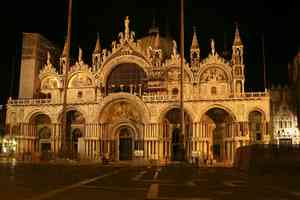 St. Mark's Basilica Big Dog of Venetian Sacred Music Source: Best Tourism |
| Born in 1495
in Belgium,
Nicolas Gombert
was a post-Renaissance composer of the Franco-Flemish School which had had its
beginnings in Burgundy, France, a generation or so earlier which was the
expansion of the Burgundian School. Gombert is
supposed to have studied under
Josquin des Prez. He was probably composing by 1525 but little
is known of his life as a young man until his hiring by Holy Roman Emperor
Charles V as a chapel singer in 1526. Like many musicians in the employ of
aristocrats and royals, Gombert likely accompanied Charles V about his
territories. As Charles V had started as Charles I of Spain that brought
Gombert's influence into the Iberian Peninsula. 1529 finds him "master of
the boys" at the royal chapel. During the thirties Gombert became a cleric
and priest, eventually receiving benefices at several cathedrals in Belgium
and France. Meanwhile serving Charles in the capacity of a musical director,
many of Gombert's compositions concerned historical moments in Emperor
Charles' reign. It is thought that in 1540 Gombert was sentenced to the
galleys for queer behavior with a boy. He was in some manner able to
continue composing while serving his term, until pardoned by Charles in
1547. There is no history of Gombert upon acquiring freedom. He is thought
to have died between 1556 and 1560, among what's left behind him being some
instrumentals, 8 settings of the Magnificat, 10 masses, 159 motets, 41 chansons, a madrigal and,
unlike other composers of the Dutch school, a Spanish canción. Gombert was among the more complex of
post-Renaissance composers, his
style simplified by successors.
References: 1,
2.
Compositions: 1,
2,
3,
4.
Scores: 1,
2.
Recordings of: 1,
2,
3.
Further reading: 'The Multivoice Sacred Music of Nicolas Gombert' by Brandi Neal (U of Pittsburgh 2011)
*.
Other profiles: 1,
2,
3,
4. Nicolas Gombert Ad te levavi oculos meos The Laudantes Consort In Te Domine Speravi Je Prens Congie Magnificat Primo Toni Stile Antico Marian Antiphon The Huelgas Ensemble Media vita in morte sumus The Oxford Camerata Mille Regrets Ensemble Clément Janequin/Dominique Visse Missa: Media Vita in Morte Sumus The Hilliard Ensemble Musea Jovis The Laudantes Consort Puisqu'ainsi Est Ensemble Clément Janequin/Dominique Visse Missa Quam Pulchra Es The Hilliard Ensemble Tulerunt Dominum Meum The Oxford Camerata |
 15th Century Recorder Preceding the birth of Gombert Source: Recorder |
|
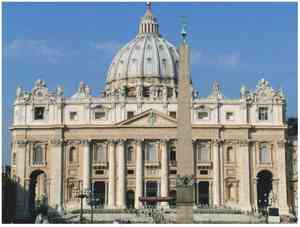 St. Peter's Basilica Center of the Counter-Reformation Source: Here I Am Lord |
Unceasing
battles between nobles and sovereigns made Christian Europe a difficult
place to live.
Thomas Tallis
faced a dangerous situation of a similar sort, composing for enemy camps on
both sides, one Catholic, one Protestant, and living to not tell about it quite comfortably.
Tallis was about twelve years old when Martin Luther sent his 'Ninety-Five Theses' to the
Archbishop of Mainz, probably on 31 October of 1517, raising issue w the papal practice of indulgences [*],
making that the generally recognized birthdate of the Protestant
Reformation. The Lutheran Church was wrought in 1521 via the Catholic Edit
of Worms banning all things Lutheran from the Holy Roman Empire. In the
meantime Luther had protection in Frederick III, Elector of Saxony, a small
puzzle piece of the Holy Roman Empire that had been conceived in 800 AD upon
Leo III naming Charlemagne Roman Emperor in Carolingian France, envisioning
a resurrection of the earlier Roman Empire. The Empire's center moved to
Germany in the 10th century under Otto I, to experience turmoil throughout
Continental Europe during Tallis' life as each piece determined itself to be either
Catholic or Protestant. Jews in the midst of it all meanwhile continued in
persecution in general as ever. Luther's first translation of the Bible appeared in
1526. William Tyndale would be working on his own (English) translation when
he was strangled at the stake in the Duchy of Brabant in modern Netherlands
in 1536, then burned, for opposing Tudor, Henry VIII's, divorce of Catherine of
Aragon to wed Anne Boleyn. Henry had been made head of the Anglican Church
through the 'Act of Supremacy' by the English Parliament in 1534, officially
severing the English Church from Rome seventeen years after the 'Ninety-Five
Theses', thirteen after the founding of the Lutheran Church in Frederick's
Warburg. (The Anglican Church is Episcopalian in the United States.) Thus the early 16th century that hosted the
high Renaissance also saw
the last of Papal power supreme throughout Europe (excepting France) before the breakaway of sections
going Protestant. Pope Julius II had only recently begun the reconstruction
of St. Peter's Basilica [*] in Rome in 1506. Its revamping would occur
throughout Tallis' lifetime, not finished until 1606. Emperor Constantine
had begun construction of the old Basilica [*] above the said tomb of St. Pater
about 325 AD, requiring only four or so decades to build. Nicholas V
(1447-55) had begun repair of the old church 12 centuries later before his
successor, Julius II, simply ordered it demolished in 1505 toward the
building of an entirely new Basilica with his own tomb added. St. Peter's
was financed by indulgences which pronounced that gifts to the Church could
improve one's fate beyond this life, which notion disturbed Martin Luther
enough to kindle the Reformation in Germany with the 1517 publication of his
'Ninety-Five Theses'. The sale of indulgences wasn't Luther's only problem
with the Church. Among others was his division on matters concerning faith
versus works. Be as may, the design of St. Peter's would require 20 popes to
eventually finish, the dome completed along the way in 1590 by architects,
Giacomo della Porta and Domenico Fontana. It would finally get crowned with
a cross under Clement VIII in 1598. In the meantime Tallis had
been a child when Michelangelo finished painting the ceiling of the Sistine
Chapel in 1512. The next year the first Medici pope, Leo X, assumed the
office of the Holy See ("Holy Seat" in Latin). The House of Medici in
Florence was among
the wealthiest commercial (not royal) dynasties in Europe. Having made its money in banking
throughout the prior century since 1397, the Medici family was a
considerable patron of the arts. It was also during Tallis' lifetime that
Franciscan friar, Matteo da Bascio, founded the Capuchins in 1528. (Friars
differ from monks in that they exist to the purpose of engaging society
rather than leaving it.) As for Jesuits, Ignatius Loyola founded the Society
of Jesus in 1540. The Church sent its first missionary to Japan in 1549, the
Spanish Jesuit, Francis Xavier. In other places on the globe Eastern
Orthodoxy in Constantinople had fallen to Muslim Ottomans half a century
before Tallis' birth. Tallis may have been about twelve when the Ottoman
Empire added Egypt to its possessions per the Mamluk War of 1516-17. Closer
to home, Tallis was born about 1505 in England. His first employment is thought to have been as an
organist at the Benedictine Dover Priory in Kent as of 1532. Likely in 1538 Tallis began working at the Augustinian monastery in Essex, Waltham Abbey.
Upon the dissolution of that church in 1540 (a casualty of the anti-Catholic
Suppression of the Monasteries by Henry VIII from 1536 to 1541) Tallis
headed for Canterbury Cathedral in Kent. In 1543 Tallis
was made Gentleman of the Chapel by Henry VIII, the latter himself a
musician (publishing the
'Henry VIII Songbook' circa 1518:
1,
2,
3,
4,
5). Tallis composed for a succession of
royalty: Edward VI, Queen Mary and, finally, Queen Elizabeth I until his
death in Greenwich on 23 Nov 1585, the same year the Egyptian obelisk was
erected at St. Peter's. Tallis had received his
own manor in Kent from Queen Mary (Catholic). In 1575 Queen Elizabeth (Protestant) granted Tallis and
William Byrd
exclusive rights to print and publish music, though not without
restrictions: they were forbidden to import and print any foreign music (largely to protect English musicians from financially damaging
competition), and such as font types were the patent of Tudor royalty only.
(Be as may, neither Tallis nor
Byrd owned a
printing press.) Royal grants of exclusive printing privileges weren't
peculiar to England and Henry VIII had earlier passed out such monopolies.
The greater privatization of printing along w other factors would eventually
arrive to the Copyright Act of 1710 or, the Statute of Anne
[see refs for copyright below]. As for Tallis, hymns began to appear in English rather than
Latin, as during his career occurred the tug of war between Roman and
Anglican liturgy (Queen Mary having been Catholic). Included in Tallis'
library are among the first Protestant compositions, including several
Lutheran chorales, even as Tallis is supposed to have remained privately
Catholic. Albeit Elizabeth granted Tallis and his younger contemporary,
William Byrd,
exclusive patent on polyphony, Tallis, at least, honored Elizabeth's puritan
tastes with simpler compositions. Be as may, 'Why Fum'th in Fight the
Gentiles Spite', below, is the basis for 'Fantasia on a Theme by Thomas
Tallis', first composed in 1910 by
Ralph Vaughan
Williams.
References for Tallis: 1,
2,
3,
4,
5,
6,
7.
Compositions: 1,
2,
3.
Scores.
Recordings of: 1,
2,
3,
4,
5,
6.
Audio at BBC.
Further reading: 'Music Printing in Britain Through 1695' *.
Biblio: 'Sixtine Rome' by Johannes Albertus & Franciscus Orbaan (Constable
1911) *.
Other profiles: 1,
2,
3,
4,
5,
6,
7,
8.
References for copyright: *;
Rob Kittredge: 1,
2,
3,
4,
5;
United States: *. Thomas Tallis Ave Dei Patris Filia The Tallis Scholars/Peter Phillips If Ye Love Me The Chancel Choir/Scott Dean If Ye Love Me Pub 1560 The Tallis Scholars Lamentation Heinavanker (The Haywain) Magnificat The Tallis Scholars/Peter Phillips Mass for Four Voices The Chapelle Du Roi Miserere Nostri 1575 The Tallis Scholars/Peter Phillips Spem in Alium Circa 1567 The Taverner Choir Why Fum'th in Fight the Gentiles Spite The Sixteen Choir |
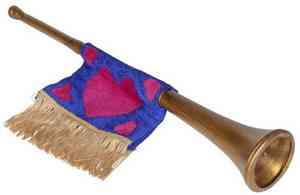 16th Century Trumpet Contemporaneous with Elizabeth I & Tallis Source: Tales of E.D. Baker |
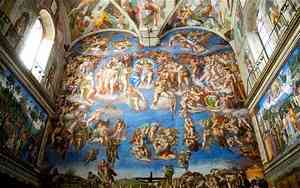 The Last Judgment Michelangelo Yet fresh paint in the pneuma of Arcadelt Source: The Telegraph |
Born about
1507, likely in Belgium,
Jacques
Arcadelt
(also Jacob) continued the influence of the Franco-Flemish school into
Italy. Probably composing by about 1520 as an adolescent, he wrote largely secular madrigals and chansons. Earliest history
of Arcadelt finds him already in Florence, Italy, as a young man in the
twenties. In 1538 he was appointed a singer in the papal choir at St.
Peter's Basilica in Rome. He eventually moved up to the position of magister
puerorum at the Sistine Chapel, meeting the remarkable painter,
Michelangelo, likely in 1942 a year after Michelangelo completed
the 'The Last Judgment' on the altar wall of the Sistine. Arcadelt
remained at the Chapel until returning to France in 1551. During his latter
career he was employed by Cardinal Charles de Guise of Lorraine, King Henry
II and King Charles IX. In 1557 Arcadelt published a book of masses in Paris. Johann Gutenberg had printed his Latin Bible a century earlier
in 1455, contemporaneous with
Binchois and
Ockeghem
above. It didn't take long for mass production to spread throughout Europe
from Germany, disseminating humanist ideas that would fuel the Renaissance. By the time Arcadelt died
on 14 Oct 1568 he had left behind some 24 motets, 125 chansons, about 200 madrigals
of certain attribution, 3 masses, some Lamentations of Jeremiah and a Magnificat.
References: 1,
2.
Compositions: 1,
2.
Scores.
Recordings of: 1,
2,
3,
4.
Audio at BBC.
Further reading:
'The Divine Arcadelt';
'Early Music Printing'.
Other profiles: 1,
2,
3. Jacques Arcadelt Ahimè dov'è'l bel viso Pub 1539 The Hillard Ensamble Ave Maria The Cantabile Choir Da bei rami scendea Pub 1542 The Mirandola Ensemble/Scott Sandersfeld Il bianco e dolce cigno Pub 1539 The Consort of Musicke/Anthony Rooley Margot, labourez les vignes Pub 1554 Ensemble D.E.U.M. Se la dura durezza Pub 1539 The Hillard Ensamble |
|
| Born circa
1508 in Verona, Italy,
Vincenzo Ruffo
became a Catholic priest as a young man in 1531, he a composer of the
Counter-Reformation as the Roman Church confronted a
Europe that it no longer dominated in Saxon Germany or Anglican England.
The painting to the right is
possibly a posthumous copy of a painting possibly by Bernardino India,
otherwise dubious. Beginning to compose about 1536, six years later he published his
first book of music while employed by Governor Alfonso d'Avalos in Milan. The next year in 1543 Ruffo was appointed choirmaster
at the cathedral in Savona. He is thought to have had to flee the Genoese
the next year, however, showing up in Milan again. In 1546 Ruffo returned to Verona where he eventually
became director of the Accademia Filarmonica in 1552/53, succeeding
composer, Jan Nasco, as leader of that group (humanists, musicians and
poets) since its founding in 1543. Though more greatly influenced by the
polyphonies of the secular
Franco-Flemish school, Ruffo composed numerous madrigals and capricci until
1465 when he began tailoring sacred music in a simpler Tridentine
style after becoming maestro di cappella at the cathedral in Milan in 1563. Tridentine
refers to the Council of Trent which held sessions from 1545 to 1563. The
Council of Trent was the brain trust of the Counter-Reformation by the Roman
Church in response to the Protestant Reformation, the music of which Ruffo
was charged to reshape into a more conservative use of harmony without
excessive ornamentations. In 1572 Ruffo became choirmaster at the cathedral
in Pistoia, a position he would also hold in Milan (again) and Sacile before
his passing in the latter on 9 Feb 1587. References: 1,
2.
Compositions.
Scores.
Recordings of: 1,
2,
3,
4.
Audio at Classical Archives.
HMR Project. Vincenzo Ruffo Amici Cantores/Stefano Torelli Le Poeme Harmonique/Vincent Dumestre Le Poeme Harmonique/Vincent Dumestre Pub 1564 Trío Intratempo Flautas de Pico Pub 1552 The Cipriano Project 1564 Harp: Margret Koell Lute: Luca Pianca Portative organ: Guillermo Perez 1564 Hespèrion XXI/Jordy Savall Le Poeme Harmonique/Vincent Dumestre Le Poeme Harmonique/Vincent Dumestre
|
Possibly Vincenzo Ruffo Source: Art UK
|
|
| Born in
Ronse, Flanders, in 1515 or '16,
Cipriano de Rore
was of the Franco-Flemish school. Speculation has Rore studying music in
Naples in 1533 while serving Margaret of Parma before her marriage to
Alessandro de' Medici, Duke of Florence, in 1536. He was probably writing
music by that time. Further speculation has
him studying under
Adrian Willaert
in Venice before 1542. Rore's composing began to become of note upon
arriving to Brescia that year, publishing his first book of madrigals,
followed by two of motets in '44 and '45. In 1546 Rore became maestro di
cappella for Duke Ercole II d'Este. The Duke awarded him a benefice (estate)
in 1556. On a return to Flanders in 1558 Rore visited Munich where his music was liked by Albrecht V
of Bavaria. In 1559 Rore made the second of two recent trips to Flanders
where his career fell into disarray for a time, his hometown destroyed at
the beginning of the Eighty-Years War during that region's struggle of
independence from Habsburg Europe. In 1560 Rore began working
in Parma, but is said to have been frustrated there. He finally managed to
acquire a position he thought he could live with in 1563 as organist at St.
Mark's Basilica in Venice upon
Adrian Willaert's
death. But he left the next year, perhaps for insufficient pay. Howsoever,
Cipriano ended up in Parma again, only to die the next year in Sep of '65 not yet fifty
years old. Cipriano had written above a hundred secular madrigals and more
than fifty motets among other sacred works. References: 1,
2,
3,
4.
Compositions: 1,
2.
Scores: 1,
2.
Recordings of: 1,
2,
3,
4,
5,
6.
Biblio: 'Cipriano de Rore: Perspectives on His Life and Music' ed. by J.A. Owens & K. Schiltz 2016
*.
HMR Project. Cipriano de Rore Ancor che col partire Pub 1547 Soprano: Roberta Invernizzi Da Pacem, Domine MS 1559 Weser-Renaissance Bremen Descendi in hortum meum MS 1559 Quire Cleveland/Ross Duffin Io canterei d'amor Pub 1550 or 1551 Musica Figurata Mia benigna fortuna Pub 1557 Huelgas Ensemble/Paul Van Nevel Kyrie of Missa Praeter rerum seriem MS sometime 1558-63 Helios Mon petit coeur Pub 1550 Huelgas Ensemble/Paul Van Nevel Parce Mihi Domine Comp at least 1558 or later Contrapunctus/David Acres Qual donna Pub 1548 Instrumental evaluation by Vincenzo Barocchieri |
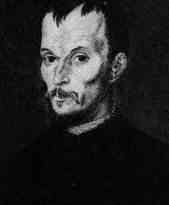 Cypriano de Rore Source: Classical Music in Concert |
|
| Born between
1514 and 1520 in Besançon in eastern France near Switzerland,
Claude Goudimel,
was a student at the University of Paris in 1549, also publishing a book of
chansons that year. By 1555 Goudimel had entered into the publishing trade with Nicolas Du Chemin, a
printer. Like other composers of the era, Goudimel was born into the lengthy
war that was the Protestant Reformation versus the Counter-Reformation.
Martin Luther, spearhead of the Reformation in Germany, had preached his
last sermon on 14 Feb of 1546, to die four days later in Eisleben [*].
But Lutheran doctrine had spread into the northeast portions of Goudimel's
France. Across the Channel in England the Reformation at Goudimel's time was headed
by theologian, Thomas Cranmer, and Tudor King, Edward VI, son of Henry VIII
who had earlier been pronounced head of the Anglican Church by act of the
Parliament. In the southwest of Goudimel's France the Reformation was headed
by John Calvin [*] w Huguenots
[1,
2]
his vehicle. Calvin issued his first edition of the 'Genevan Psalter' in
French in 1539, that to the purpose of supplying Protestant churches a
hymnal for congregational singing. The Psalter would eventually accrue to a
complete collection of the 150 'Psalms' of the 'Old Testament' w melodies
written by Clement Marot, Theodore de Beza, a few by Calvin and forty by one
Maistre Pierre, perhaps Pierre Davantès. In 1972 the Canadian Reformed Churches published an English translation of
Calvin's 'Psalter' titled 'Book of Praise' [scores: 1,
2].
Goudimel’s first Genevan psalter
was published in 1562 in Paris by Le Roy and Ballard. Melodies were taken
from the Genevan Psalter of 1551
[1,
2,
3,
4;
scores].
Apt to note that in relating Goudimel to Calvin's hymnal it
is always in terms of harmonies embellishing upon melodies composed by
others. It is those melodies that church congregations sang, not Goudimel's
polyphonic elaborations for multiple parts for performance in other
settings. Opportune to comment here on the significance of the 'Book of Psalms'
[1,
2,
3,
4,
5,
6,
7,
8].
Christians were singing from 'Psalms' ("prayers" ) from the begin. Songs from 'Psalms',
about half written by King David of Israel
[*] in the
9th and 10th centuries BC, will have a strong presence
throughout the history of choral music in Europe and gospel in the United
States. As for Goudimel, in 1557 he went to Metz and became a
Protestant, involving himself with the Huguenot reform movement there. In
1564 'Vingt Six Cantiques Chantés au Seigneur' [*] was published by
librettist, Louis des Masures, for which Goudimel composed the four-part harmony.
The same year he published all 150 psalms of the 'Genevan Psalter'. Metz,
however, was a Catholic town, so as enmity against Protestants increased Goudimel returned
perhaps about 1467 to the less hostile
environment, for Protestants anyway, of his birthplace, Besançon. Goudimel
harmonized the whole 'Genevan Psalter' again for publishing in 1568. Goudimel
made the fateful decision of leaving Besançon for
Lyon in 1572. The St. Bartholomew's Day massacre [1,
2,
3,
4,
5] in
latter August that year,
largely in Paris but other provinces as well, ended in the slaughter of some
ten to thirty thousand Protestants, Goudimel among them. To be at the wrong
place at the wrong time was nigh automatic for anyone anywhere in the Europe
of Goudimel and all that had preceded for a few thousand years. Goudimel had
been a composer of above 70 secular chansons, sacred masses and numerous motets
including those of his harmonies. References: 1,
2,
3.
Compositions: chansons; 'Geneva Psalter'
harmonies:
1551,
1564,
1568;
motets.
Scores.
Recordings of: 1,
2,
3,
4,
5.
IA.
Further reading: James McKinnon.
Biblio: 'The Genevan Psalms in Harmony' by Claude Goudimel edited by Theresa Janssen (Inheritance Publications 2006);
'The Genevan Psalter of 1562 Set in Four-Part Harmony by Claude Goudimel in 1565' by G.R. Woodward
*;
'Louis des Masures, Claude Goudimel et Jen de Tournes' by Emma Herdman (Bibliothèque d'Humanisme et Renaissance 2004)
*.
Other profiles: 1,
2.
See also 1,
2.
Dates below refer to
the year of publication by Goudimel. Claude Goudimel The Genevan Psalter: Psalm 2 1564 Ernst Stolz The Genevan Psalter: Psalm 8 1564 Ernst Stolz The Genevan Psalter: Psalm 51 1562 Ernst Stolz The Genevan Psalter: Psalm 52 1562 Ernst Stolz The Genevan Psalter: Psalm 68 1562 Ernst Stolz The Genevan Psalter: Psalm 71 1562 Ernst Stolz The Genevan Psalter: Psalm 72 1564 Ernst Stolz The Genevan Psalter: Psalm 73 1562 Ernst Stolz The Genevan Psalter: Psalm 110 1562 Ernst Stolz The Genevan Psalter: Psalm 145 1562 Ernst Stolz Il me semble que la journée La Chorale de Laclef des Champs/Benjamin Vinit |
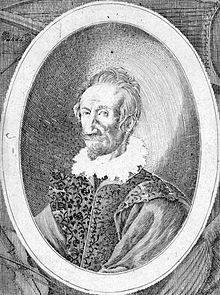 Claude Goudimel Source: Wikipedia Thanks to Nhu Thao for help w this photo |
|
| Born circa
1520 in Tuscany, Italy,
Vincenzo Galilei
was a lute player and music theorist who concerned himself with grounding
the music of his period in Greek monody. We've seen the lute [1,
2,
3] before in
this history, as it was the darling of medieval secular music as compared to
the organ of sacred. The lute dates back to about 3100 BC Mesopotamia and is related to
the Arabian oud ("wood")
via which it entered into European culture. Preceding the guitar, lutes were
originally fretless. Though Galilei is thought to have played lute from an early age
next to nothing else is known about his early life. He is known to have
married into an aristocratic family some time before 1562. In 1563 when he went to Venice to study with
music theorist, Geoseffo Zarlino [*].
Later that year he published 'Intavolature de
Lauto' ('Lute
Tablature') also referred to as Galilei's 'First Book of Lute Music'.
Wikipedia has tablature [1,
2,
3,
4,
5], as compared to
standard notation, emerging in
Germany not for string instruments, but organ, about 1300, a little later
than the emergence of the four and five line staff (stave) in Italy. Galilei was 44 years of age in 1564 when his contemporary,
Michelangelo, sculptor of the High Renaissance died. That same year his wife gave
birth to the first of six children, the astronomer, physicist and engineer, Galileo
[*], on 15 February.
Galileo also played lute.
Galilei's first edition of 'Fronimo Dialogo' ('Wise Dialogue') appeared in 1568,
his
second book treating tablature. 'Primo libro di Madrigali a 4 e a 5 voci'
saw publishing in 1574. Another of Galilei's sons was composer and lutenist,
Michelagnolo Galilei,
born in 1575. In 1581 Galilei's important treatise, 'Dialogo della music a antics et della
modern', appeared, that a criticism of Zarlino's polyphonic counterpoint
whilst recalling harmonics according to Greek antiquity. Second editions of 'Il Fronimo'
and
'Libro d’Intavolature di Liuto' appeared in 1584 as well as a book of fugues
titled 'Contrapunti a Due Voci'. A second volume of 'Madrigali a 4 e a 5 voci'
arrived in 1587. Come 'Discorso
intorno all'opere di messer Gioseffo Zarlino' in 1589. Though Galilei wrote
sacred music he was largely a secular composer. As a
member of the Florentine Camerata
[1,
2],
a group of Renaissance intellectuals, he was of considerable influence in
emphasis on Greek harmonics. Also principle in his
studies was acoustic science addressing such as the mathematics of string vibration
[1,
2,
3,
4]. Galilei'
died on 2 July 1591, his scholarly works of the latter Renaissance of no
small affect on baroque composers just ahead with the calendar rolling into
the 17th century. References: 1,
2,
3.
Compositions.
Scores.
Recordings of: 1,
2,
3,
4.
Authorship: 'Intavolature de Lauto' ('Lute Tablature') 1563:
1,
2;
'Fronimo Dialogo' 1568:
1,
2;
'Dialogo della music a antics et della modern' 1581:
1,
2,
3,
4;
'Fronimo Dialogo' 1584:
1,
2;
'Libro d’Intavolature de Lauto' 1584:
1,
2,
3,
4;
'Discorso intorno all'opere di messer Gioseffo Zarlino' 1589
*;
various.
Discussion.
Bibliography: 'Instrumentalists and Renaissance Culture' 1420-1600 by Victor Coelho-Keith Polk (Cambridge U Press 2016)
*;
'Music and Science in the Age of Galileo' by V. Coelho (Springer Science & Business Media 1992)
*;
'The Order of Things: A Reappraisal of Vincenzo Galilei's Two Dialogues Fronimo 1568 and 1584' by Peter Argondizza
*; 'The Pontificate of Clement VII' 1300-1700 by Sheryl Reiss (Routledge 2017)
*;
'Where Nature and Art Adjoin: Investigations into the Zarlino-Galelei Dispute' by Randall Goldberg
*.
Other profiles: 1,
2,
3,
4,
5.
See also 1,
2. Dates below refer to year of
publication. Vincenzo Galilei La Caccia 1584 Valery Sauvage Duo tutti di fantasia 1584 Lutes: Thierry Meunier & Jean-Marie Poirier Contrapunto Primo 1584 Lutes: Thierry Meunier & Jean-Marie Poirier Contrapunto Secondo 1584 Dulciana: Paolo Tognon Liuto: Pier Luigi Polato Gagliarda Calliope 1563 Valery Sauvage |
||
| Born circa
1520 in Montreuil-sur-Mer in northern France,
Adrian Le Roy
was a string musician who played the cittern, lute, guitar and mandore.
We've discussed the lute before as the most popular instrument of the
Renaissance. The cittern [1,
2] was a recent development compared to the ancient
lute, traveling from Italy in the 15th century to Britain where it came to
significant presence. The
guitar in its present form evolved largely of entrance into France from
Spain in the early 16th century contemporaneously with Le Roy. The
mandore
arrived in the latter part of the century. Earliest records of employment find Le Roy
with Claude de Clermont, then Jacques II, Baron de Semblançay and Viscount
of Tours. He married the daughter of publisher, Jean de Brouilly, in Paris
in 1546. Le Roy founded the printing firm, Le Roy & Ballard
[*], in 1551 with
Robert Ballard, obtaining the privilege to publish from King Henry II.
(Albeit the invention of movable type in Germany by Gutenberg, about 1440,
had sparked intense competition by early publishing houses, one couldn't
print just as one pleased during the Renaissance, and especially not during
the Reformation [1517-1648]. Press was rigidly controlled. The first
newspaper, incidentally, wasn't published until 1605 by Johann Carolus in
Germany.) With Ballard assuming the business tasks and Le Roy making the
editorial decisions, Le Roy and Ballard became the largest and most
successful publishing house in France by the seventies and would remain in
business into the 19th century. Their first book "off the press" was Le
Roy's 'Premier Livre de Tablature de Guitar' ('First Book of Tabs for Guitar' in
1551
[*]. Such as notation and tablature have already seen mention in this
history, but we've thus far neglected one of the more important aspects of
music that is dance. Dance, of course, is nothing new from the ancient
[1,
2] belly
dance or Judeo-Christian [*] dance through medieval
[*] dance to
Renaissance [*]
dance to whatever dance it is now. Le Roy's first book included tablature for
the branle and the
almande. "Branle" means to shake or sway in French,
which dance of the common people emerged in the 16th century w dancers
chaining in a circle, hips side to side (Le Roy's
'Branle Simple'
of 1551). "Almande" (to become allemande) is loosely French for "German dance" which
form of the aristocracy also surfaced in the 16th century, a popular dance
alongside the later minuet (French) until the waltz (Austro-German) largely
took the place of both in the 19th century. Though the allemande focused on
disciplined formality, it was nevertheless at root of the more lively square
dance [1,
2]. By Le Roy's time numerous forms
or genres of music sacred and secular were in array, necessitating a kind
that wasn't bound to form, that being the fantasy
(fantasia, fancy, et al), also originating in the 16th century during Le
Roy's lifetime. Fantasies (ideas) which applied to such as didn't quite fit
established proper forms were, in a sense, a little like free verse, free
jazz or the improvisational preamble with which a guitarist might warm up
before breaking into a tune. From 1551 to 1598 Le Roy published 22 books of
which 13 survive. Five books featured instruction and tablature for guitar,
five for lute, two for mandore and five for cittern. Adding later editions
and English translations wrought 16 volumes on guitar and 17 on lute
[Guitare Renaissance].
Le Roy also wrote numerous chansons and
airs,
the latter originating contemporaneous to Le Roy in the latter 16th century. Among the latter,
originating contemporaneous to Le Roy in the latter 16th century, was Le
Roy's 1571 'Airs de cour miz sur le luth' ('Book on Court Tunes for the Lute') which much
occasioned a transition from the chanson to the air (du cour) in popular
French music, also a favorite style in England. Le Roy also pushed the success of composer,
Orlande de Lassus,
introducing him to the royal court and publishing his work in 1576 and 1584.
Probably composing since about 1540 as youth, Le Roy died in
Paris in 1598. References: 1,
2,
3.
Tablatures.
Books by: Johann von Solothurn:
'Premiere Livre de Tablature de Guitar' (1551)
*;
'Tiers Livre de Tablature de Guitar' (1552)
*;
'Cinqiesme Livre de Guiterre' (1554)
*;
'Second Livre de Guiterre' (1556)
*;
Wikipedia.
Recordings of: 1,
2,
3.
Bibliography: 'The Guitar Books of Adrian Le Roy and Robert Ballard
(1551-1555): An Anthology' by Robin Brower (U of Southern California 1992). Dates below refer to year of publication. Adrian Le Roy Almande 1551 Lute: Valery Sauvage Almande: La Mon Amy La 1551 Guitar: Myriam Plante Almande: Le Pied de Cheval 1552 Guitar: Valery Sauvage Branle de Bourgongne Guitar: Jean-François Delcamp Bransle de Champaigne: Alemande du pied de cheval Guitar: Eric Bellocq Branle Simple: N'aurez vous point de moy pitié Guitar: Daniel Fantasies 1-2 Guitar: Jocelyn Nelson Passemeze Guitar: Jean-François Delcamp Tourdion Guitar: Valery Sauvage |
||
| Born
sometime between Feb 1525 and Feb of '26
in Palestrina, Italy,
Giovanni Pierluigi da Palestrina
was a pinnacle figure in Italian sacred music who began his career during the High
Renaissance. He would have
been heavily influenced by the Franco-Flemish school during studies as a
young musician, but by the end of his career the Roman school would come to
exist in its own right. Earliest records find him in Rome singing in the
choir at the Basilica di Santa Maria Maggiore in 1537. He was an organist
from 1544 to 1551 at the cathedral of St. Agapito in Palestrina where he'd
begun composing. Pope Julius III appointed him
maestro di cappella at the Julian Chapel at St. Peter's Basilica [*]
in 1551. During the coming years he held similar positions at other chapels
and churches in Rome. Returning to Julian Chapel in 1571, Palestrina there
remained until his death of pleurisy on 2 Feb 1594. Palestrina was among the more prolific of
Renaissance composers. Though Palestrina was largely a composer of sacred
music, he write a good number of "profane" (secular) madrigals
as well as a spiritual variety. Of sacred music, Palestrina left behind at least 105 masses, 68
offertories (Eucharistic), 300 motets, 72 hymns, 35 Magnificats, 11 litanies and several
lamentations. Hymns included antiphons (lyrics borrowed from the 'Psalms')
and canticles (lyrics borrowed from the Bible excepting, in Catholicism,
'Psalms'). References encyclopedic: 1,
2,
3;
Wikipedia: 1,
2,
3.
References musical: 1,
2,
3,
4,
5;
Palestrina Foundation.
Compositions: 1,
2,
3.
Scores.
Audio.
Recordings of: 1,
2,
3,
4,
5.
IA.
Documentaries: 'Palestrina - Prince of Music' directed by Georg Brintrup (2010)
*.
Other profiles encyclopedic 1,
2; musical:
1,
2; Wikipedia:
1,
2. Giovanni Palestrina Adoramus Te Crown College Choir/David Donelson Alma Redemptoris Mater Quire Cleveland/Jameson Marvin First Book of Madrigals Concerto Italiano/Rinaldo Alessandrini Magnificat IV Toni I Cantori della Resurrezione/Antonio Sanna Missa: O Sacrum Convivium: Gloria Christ Church Cathedral Choir Missa: O Sacrum Convivium: Kyrie Christ Church Cathedral Choir Missa: Papae Marcelli The Tallis Scholars/Peter Phillips O Magnum Mysterium Motet 1569 Mainz Chamber Orchestra/Gunter Kehr Sicut Cervus Voices of Ascension/Dennis Keene Stabat Mater Choir of King's College/Sir David Willcocks Super Flumina Babylonis Pub 1604 University of Bologna Choir/Enrico Lombardi |
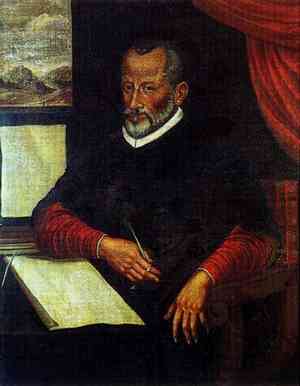 Giovanni Palestrina Source: Wikipedia |
|
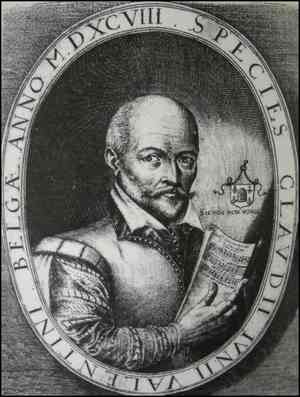 Claude Le Jeune Source: Wikipedia |
Conceived in
Valenciennes in northern France some time between 1528 and 1530,
Claude Le Jeune was
educated in the Franco-Flemish school. He was also among the first
Protestant composers on the Continent (preceded as a Protestant composer by
Thomas Tallis
in England a generation earlier). His major years as a composer commencing
about 1550, first records of Le Jeune find four of his
chansons being published in Leuven in 1554. Like
Tallis in
England, the Reformation found Le Jeune working for both sides of enemy
camps. Moving to Paris in 1564, Le Jeune became involved with the Huguenots,
a group of reformed Protestants of the Calvinist vein gathering force since
the thirties. He nevertheless also involved himself with the Academie de Musique et de
Poésie under Catholic, Jean-Antoine de Baïf, in 1570
[1,
2,
3,
4].
As a theorist, like
Vincenzo Galilei,
Le Jeune educated himself in ancient Grecian music. His major claim to fame
was his secular "Parisian" chansons and airs in the manner of musique
mesurée [1,
2], a style developed to complement vers mesurée, itself a style
developed by poets under the leadership of Baif. Those chansons
would be among the last of such kind, as the chanson
had begun transitioning toward the air du cour [1,
2,
3,
4]
in popular French song in the latter 16th century. Moving ahead some years, Le Jeune
was living in La Rochelle when he was discovered to be the author of an
anti-Catholic tract in 1589 and was forced to flee Paris. Le Jeunes's
slightly older contemporary,
Claude Goudimel, had been killed
by Catholics in Lyon during the St. Bartholomew's Day Massacre in Lyon in August of
1572. Acquiring employment by Huguenot king, Henry IV, with whom he remained
the last years of his life, he published ''Dodecacorde:
Comprising Twelve Psalms of David Set to Music'' in 1598
[click image to read: 1,
2,
3;
A-R Editions 1989: 1,
2]. Le Jeune's last
finished work prior to his death was 'Octonaires de la vanité et inconstances du
monde' ('Eight-line Poems on the Vanity and Inconstancy of the World').
Consisting of 36 movements based on the poems of Antoine Chandieu, that saw posthumous publishing in 1606
[1,
2;
recordings of: 1,
2]. Le Jeune died in Paris in 1600, buried
on 26 September. His book, 'Les Cent Cinquante Pseaumes de David' (The 150
Psalms of David') saw
publishing posthumously in 1601 [1,
2] followed by ''Pseaumes En Vers Mezurez'' in
1606 [1,
2,
3,
4]. Le Jeune had composed no small amount of sacred music, including 347
psalms, 38 sacred chansons, eleven motets and a mass. Secular works included
43 Italian madrigals.
References: 1,
2.
Compositions: 1,
2.
Scores.
Recordings of: 1,
2,
3,
4.
Audio at BBC.
IA.
Bibliography: books: 'The Chansons of Claude Le Jeune' by Kenneth J. Levy (Princeton U 1977)
*;
'Claude Le Jeune: Complete Unpublished Chansons' by Jane Bernstein (Taylor & Francis 1990);
journals: 'The Aims of Baïf's 'Académie de Poésie et de Musique'' by D.P.
Walker (Journal of Renaissance and Baroque Music Vol 1 No 2 1946)
*; 'French psalms, chansons spirituelles and musique mesurée' by Marie-Alexis Colin & Frank Dobbins ('Early Music' Vol 29 No 1 Oxford U Press 2001)
*;
'The Influence of 'Musique mesurée à l'antique'' by D.P. Walker (Musica Disciplina Vol 2 American Institute of Musicology 1948)
*;
'Vers mesurés, vers mesurés à l’antique' by Howard Brown/ Richard Freedman
*.
Other profiles: 1,
2,
3.
Further reading *.
Claude Le Jeune La Guerre (War) Ensemble Clément Janequin & Dominique Vissee Je Suis Deshéritée Ensemble Clément Janequin & Dominique Vissee Une Puce Ensemble Clément Janequin and Dominique Vissee Qu'est devenu ce bel oeil Ensemble Clement Janequin Reveci venir du printemps Suzie Le Blanc Revecy venir du printemps University Singers Tout ce qui est de plus beau dans les cieux Ensemble Clément Janequin & Dominique Vissee |
|
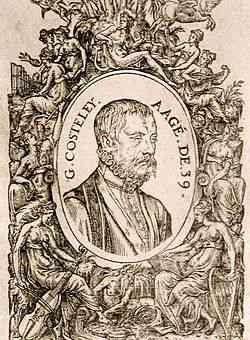 Guillaume Costeley Source: Wikipedia |
Born in the
province of Auvergne in southern central France in 1530/31,
Guillaume Costeley had
arrived in Paris by 1554 to study music theory, and was first published that
year in volumes printed by Nicolas Du Chemin. He began making himself
known by the late fifties upon
Le Roy and Ballard
publishing compositions by him in 1559. From there he became organist at
the royal court of King Charles IX about 1566, as well as music teacher to
the ten year-old monarch. In 1570 Costeley published 'Musique de Guillaume
Costeley' [*],
containing the majority of his surviving oeuvre. Costeley was a
founding member of the Académie de Poésie et de Musique
[1,
2,
3,
4],
an important
salon, founded by Jean-Antoine de Baïf, which interest was to
resurrect Grecian studies and styles. Such the intellectual assembly became
the first of successive French academies surviving into the 20th century.
Among those composers unmarked by the Reformation, Costeley was eventually
well rewarded for his services to Catholic sympathizer, Charles IX. As there
are no records of compositions by him following 1570 he may have largely retired
from composing upon moving to Évreux. Charles required his
services at organ only the initial three months of the year, leaving him free the
remainder which he employed at least in part purchasing a wealth of
properties. Come 1581 he was employed as a tax assessor. 1597 found Costeley in the rather enviable position of Conseiller du Roy (Advisor to
the King) under Henry IV, which he held until his passing on 28 January 1606. Costeley had composed
very little sacred music, his brief career of fifteen years resulting in
some hundred secular chansons. Thanks to Roger Wibberley below, a keyboard
version of 'Seigneur Dieu ta Pitié' can be heard, making opportune a brief
but needful
mention of the
harpsichord [1,
2,
3,
4],
an instrument of no small significance during the Renaissance.
The oldest specimen of a complete harpsichord dates to 1521 in Italy, about
ten years before Costeley's birth. To the right is a later Flemish harpsichord
circa 1600, six years before Costeley's death. References: *.
Compositions: 1,
2.
Scores.
Recordings of: 1,
2,
3,
4,
5.
Audio at BBC.
IA.
HMR Project. Guillaume Costeley Allons Gay Bergeres A Sei Voci Allons au vert bocage The Stairwell Carollers Mignonne, allons voir si la rose The Young Friends of Music Choir/Ugrin Gábor La Prise du Havre La Menestraudie Seigneur Dieu ta Pitié Keyboard: Roger Wibberley Las, je n'irai plus jouer au bois La Ménestraudie |
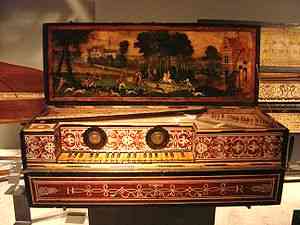 Flemish Harpsichord Circa 1600 Source: Wikipedia |
|
Probably born in 1532 in Mons, which would be
modern-day Belgium,
Orlande de Lassus
(Lasso) takes one to the latter period of the Franco-Flemish Renaissance in
music before baroque counterpoint in Italy arrived about 1600. Lassus began traveling about Italy at age twelve. Perhaps composing
by 1550, his first known
employment was as a singer for Costantino Castrioto in
Naples. He
next worked for Cosimo I de' Medici, Grand Duke of Tuscany, in Rome. In 1553
Lassus became maestro di cappella of the Basilica of Saint John Lateran,
leaving a year later. He began publishing his works in 1555 in Antwerp. In
1556 he obtained appointment to the court of Albrecht V, Duke of Bavaria, in
Munich. By the sixties Lassus' fame had spread such that he began to teach.
He entered the seventies by receiving noble rank from Emperor Maximilian II
in 1570. Pope Gregory XIII knighted him as well. While working in Munich he
made several visits to Italy, most notably to the House of Este in Ferrara.
His last finished work was a set of twenty-one madrigali spirituali:
'Lagrime di San Pietro' ('Tears of St. Peter'), published posthumously in
1595, for Lassus died on 14 June 1594 in Munich. He hadn't seen the letter which
arrived the same day, dismissing him from employment to the royal court for
financial reasons. Lassus left behind more than 2000 compositions, including
530 motets, 175 Italian madrigals and villanellas
[*], 150 French chansons, and
90 German lieder (songs). The villanella was a form of popular song developing in Naples
in the latter 16th century. References: 1,
2,
3,
4,
5,
6.
Compositions: 1,
2,
3.
Scores.
Recordings of: 1,
2,
3,
4.
Audio: 1,
2,
3.
IA.
Other profiles: 1,
2,
3,
4,
5,
6,
7. Dates below refer to year of publication. Orlande de Lassus De Profundis Clamavi Christ Church Catherdral Choir Il Magnanimo Pietro Ensemble Vocal Européen/Philippe Herreweghe Lamentationes Ensemble Vocal Européen/Philippe Herreweghe Album: 'Lassus: Hieremiae prophetae lamentationes' Matona, Mia Cara 1581 Hilliard Ensemble Missa Pro Defunctis The Collegium Regale/Stephen Cleobury Osculetur Me Osculo 1582 Tallis Scholars Psalmi Collegium Vocale Gent/Philippe Herreweghe Album: 'Lassus: Psalmi Davidis poenitentiales' Susanne un Jour Soprano: Arianna Savall Tristis est anima mea 1565 Regensburger Domspatzen/Roland Büchner |
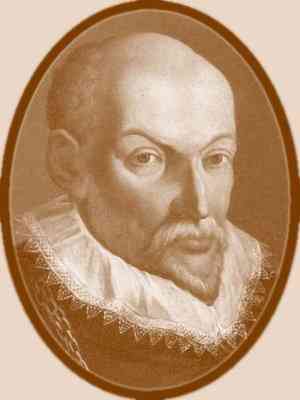 Orlande de Lassus Source: Music Timeline |
|
| Born in
Venice in 1532/33,
Andrea
Gabrieli
greatly increased the contributions of the Venetian school to European music
apart from the Franco-Flemish school which dominated music throughout the
Renaissance. He may well have studied under
Adrian Willaert
at St. Mark's in Venice alike his slightly earlier contemporary, Gioseffo
Zarlino. Though most of Gabrieli's works were not published until after his
death his influence throughout Europe exceeded that of Zarlino. Among the
earliest references to Gabrieli is the publishing of one his madrigals in
1554 in Venice by Giralamo Scotto. This was his 'Piangete occhi miei lassi'
appearing in a book devoted largely to
Vincenzo Ruffo titled 'Li
madrigali a cinque voci scielta seconda'. In 1557 Gabrieli became an organist in Cannaregio. 1562 found
Gabrieli traveling to Frankfurt and Munich to work with
Orlande de Lassus.
In 1566 Gabrieli became organist at St. Mark's in Venice, a position he
held, while teaching, to the end of his life on 30 Aug 1585. Gabrieli succeeded in
distinguishing the Venetian school in its own right from the Franco-Flemish
school that had dominated the Renaissance and been the background of
Williaert
under whom he may have studied.
References: 1,
2,
3.
Compositions: 1,
2.
Scores.
Recordings of: 1,
2,
3,
4,
5.
Audio at BBC.
IA.
Other profiles: 1,
2,
3. Dates below refer to year of publication if not
composition. Andrea Gabrieli 1554 - 1585 Battaglia à 8 Symposium Musicum/Miloslav Klement Christe à 8 Gabrieli Consort/Gabrieli Players/Paul McCreesh Gloria à 16 Pub 1587 Gabrieli Consort/Gabrieli Players/Paul McCreesh Magnificat à 12 Chanticleer Maria Magdalene Missa Brevi: Sanctus Cantate Domino O Sacrum Convivium à 5 Pub 1565 Gabrieli Consort/Gabrieli Players/Paul McCreesh Psalmi Davidici Ricercar del duodecimo tuono Ensemble Instrumental de Paris/Hollard Florian Sanctus and Benedictus 'Missa Brevis in F' Cantores Carmeli/Michael Stenov Toccata del nono tono Organ: M. Raschietti |
||
| We pick up
Claudio Merulo's
career, born 8 April 1533 in Corregio in northern Italy, upon his first
association with St. Mark's Basilica in Venice as a young man. Estimated to
have been composing by about 1550, he likely
studied under Gioseffo Zarlino at St. Mark's. He was appointed an organist at Old
Cathedral in Brescia in 1556, and worked there simultaneously with his
appointment as organist at St. Mark's a year later as well. Merulo
eventually rose to such status as to compose the music in celebration of
Henry III's visit to Venice in 1574 en route from Poland to crowned King
France in Paris. In 1584 Merulo exchanged
Venice for Parma, working at Parma Cathedral, as well as the Church of Santa
Maria della Steccata. Though Merulo made trips to Venice and Rome he
remained in Parma until his death on 4 May 1604. Taught during a period when
by that time the
Venetian school had since distinguished itself from its Franco-Flemish
influence via
Adrian Willaert, among Merulo's fortés
were his toccatas
[1,
2] especially for keyboard.
Toccatas were brief free forms written to display instrumental virtuosity.
Merulo also addressed free form ricercars as well as canzonas
descended from the Franco-Flemish chanson. He published four books of madrigals in 1566, 1579, 1580 and 1604.
He otherwise wrote numerous motets.
References: Wikipedia;
All Music.
Compositions.
Scores.
Audio.
Recordings of: 'Toccate d'Intavolatura d'Organo' 1598/1604 w organ by Francesco Tasini
issued 2010 *;
Discogs;
Naxos.
IA.
Other profiles:
1,
2,
3. Dates below refer to year of publication if not
composition. Claudio Merulo Canzon à 4 dita: La Zambeccara 1592 Clavicembalo: Marco Vincenzi Canzona vigesimaterza Ernst Stolz Missa: Kyrie: in dominicis diebus Organ: Massimiliano Raschietti Missa: Kyrie: virginis Mariae Die Choralschola St. Joseph-Weinhaus O Crux Benedicta 1578 Quoniam Ensemble Sanctus a 12 voci Cantar Lontano/Marco Mencoboni Toccata: prima 1604 Organ: Stefano Molardi Toccata: quarta del sesto tono 1604 Organ: Massimiliano Raschietti Toccata: quinta del secondo tono 1598 Organ: Massimiliano Raschietti |
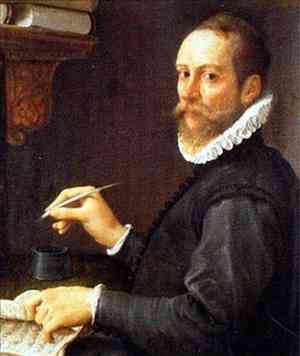 Claudio Merulo Painting: Annibale Carracci Source: All Music |
|
| Born in
1535 or 36 in Verona, Italy, though
Marc'Antonio Ingegneri
wasn't a major composer in comparison to some, he was the teacher of
Claudio Monteverdi during the late Renaissance. Thought to have
been composing by about 1565, Ingegneri was a fellow student of contemporary,
Cypriano de Rore, in Parma. He likely studied under
Vincenzo Ruffo in Verona as
well. Circa 1570 found Ingegneri composing in Cremona, probably working as
an organist and string player too. Ingegneri became maestro di cappella of
the cathedral in Cremona in 1581, where he would soon be teaching music to
Claudio Monteverdi. Though he spent the remainder of his life in Cremona in
northern Italy, Ingegneri has generally been identified with the Roman
school. By the time of his death in 1592 he left behind a couple books of
masses, three books of motets from among others thought lost and eight
volumes of madrigals. References: 1,
2.
Compositions: 1,
2.
Scores.
Recordings of: 1,
2.
HMR Project. Marc'Antonio Ingegneri 1588 Choir of St. Andrew’s Episcopal Church Michael T. Kevane Responsoria hebdomadae sanctae Animam meam dilectam 1588 Cori e Cappella Mauriziana/Mario Valsecchi Responsoria hebdomadae sanctae Caligaverunt oculi mei 1588 Cori e Cappella Mauriziana/Mario Valsecchi Responsoria hebdomadae sanctae Vinea mea electa 1588 Cori e Cappella Mauriziana/Mario Valsecchi Responsori della Settimana Santa Amicus Meus 1588 Il Coro Sicardo di Cremona/Fulvio Rampi Responsori della Settimana Santa Velum Templi 1588 Il Coro Sicardo di Cremona/Fulvio Rampi Le Choeur de May/Nicolas Wyssmueller
|
|
|
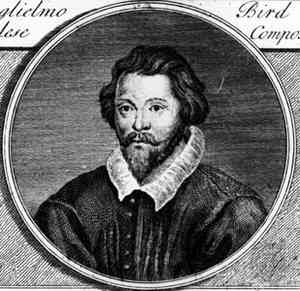 William Byrd Source: Wikimedia Commons |
Born 1540 to
1543 in London,
William Byrd,
of status gentlemanly, continues the Renaissance in music in England. Though
he composed some works in madrigal form his concern was largely sacred music.
Estimated to have been composing seriously as a youth about 1555, he very likely studied under
Thomas Tallis
as a young man. Like
Tallis, indeed, to a great portion with
Tallis, Byrd would weather the storm
between the Anglican and Roman churches in England during the Reformation
and emerge not only undamaged but financially secure. His first known
employment was in 1563 as organist and choirmaster at Lincoln Cathedral,
Church of England (tallest building in the world for more than two hundred
years since its erection about 1311). He was eventually paid to compose for
that cathedral as well. In 1572 Byrd was appointed Gentleman of the Chapel
Royal by Queen Elizabeth I. In 1575 Byrd and
Tallis were granted a monopolistic
printing patent of 21 years by the Crown (largely to prevent foreign
influence on English music, Catholic and otherwise). Royal grants of
exclusive printing privileges weren't unique to England and Henry VIII had
earlier passed out such monopolies being at root to copyright law. The
greater privatization of printing along w other factors would eventually
arrive to the Statute of Anne or, the Copyright Act 1710 [see refs for
copyright below]. As for Byrd and
Tallis, they jointly
published 'Cantiones que ab argumento sacrae vocantur' in 1575. Upon the financial
failure of the book, Elizabeth I compensated the duo with land leases. Byrd is thought to have become a Catholic
in the seventies, which began to become dangerous to him in the eighties. In
1583 he was temporarily suspended from the Royal Chapel, his movements
restricted and his house searched for evidence of complicity in the failed
Throckmorton Plot to assassinate Elizabeth. Cleared of suspicion, Byrd
emerged to publish several books: 'Psalms, Sonnets and Songs of Sadness and Pietie' (1588), 'Songs of Sundrie Natures' (1589) and two books of sacred
cantiones in 1589 and 1591. Also in 1591 'My Ladye Nevells Booke' was
published, not by Byrd though likely in association with him, featuring 42
of his keyboard pieces. In 1594 Byrd moved to Stondon Massey in Essex,
likely in semi-retirement, and likely attending Catholic Masses in secret.
Byrd is known, instead, to have been fined for recusancy during this period
(not attending Anglican services). What Byrd reveals about the Reformation
in England under the Tudors is that it was all right for a select few to be
Catholic so long as such was kept mum and one stayed clear of violence. One
also learns that one can write Catholic motets, call them Anglican, and no
one may ever know the difference. In 1605 and 1607 Byrd published Books I
and II of the 'Gradualia', consisting of sacred motets. In 1611 his 'Psalms,
Songs and Sonnets' appeared. Byrd's last published works appeared in 1614,
four of his anthems appearing in William Leighton's 'Teares or Lamentacions
of a Sorrowfull Soule'. Byrd died fairly well-off as mammon went at the
time, having rooms at the home of the Earl of Worcester. The year was 1623,
Byrd's passing noted in the register of the Royal Chapel with "a Father of
Musick" appended. Byrd's compositions number about 470 in all.
References for Byrd encyclopedic: 1,
2
(alt),
3;
literary: *;
musical: 1,
2,
3,
4,
5.
Compositions: 1,
2,
3,
4.
Scores.
Publications:
'Cantiones Sacrae' 1575: 1,
2;
'Psalmes, Sonnets and Songs' 1588:
1,
2;
'Gradualia ac cantiones sacrae - Liber 1' 1605
*,
'Gradualia ac cantiones sacrae - Liber 2' 1607
*.
Recordings of: 1,
2,
3,
4.
Audio: John Sankey at keyboards (midi files): *
(alt).
Further reading: 1,
2,
3,
4,
5.
Bibliography: 'The Byrd Edition' edited by Philip Brett (complete corpus of vocal works)
*;
'Keyboard Music I & II' edited by Alan Brown (1969/71)
*;
'William Byrd: A Research and Information Guide' by Richard Turbet (Routledge 2012)
*.
Other profiles: 1,
2,
3,
4,
5,
6.
Recordings: 1,
2,
3,
4.
Copyright: Rob Kittredge: 1,
2,
3,
4,
5.
Dates below refer to year of publication if not composition. William Byrd Ave Verum Corpus 1605 The Tallis Scholars The Battell 1581-91 Philip Jones Brass Ensemble/Elgar Howarth Justorum Animae 1605 Worcester Cathedral Choir Lullaby 1588 The Tallis Scholars Mass for Five Voices 1593 The Tallis Scholars Mass for Four Voices 1592-93 The King's Singers Sing Joyfully Choir of Clare College/Cambridge Songs of Sundrie Natures 1589 Hilliard Ensemble & the London Baroque/Paul Hillier Tristitia et Anxietas The Tallis Scholars Vigilate The Tallis Scholars |
|
| Born in 1545
in Ferrara, Italy,
Luzzasco Luzzaschi
was a pupil of
Cipriano de Rore.
In 1564 he was appointed organist to the House of Este. Luzzaschi was highly
regarded for his madrigals and keyboard abilities. He also worked with the
Concerto delle donne, a female ensemble formed by Alfonso II, Duke of
Ferrara, which duty it was to perform for exclusive audiences. Though
employed to sing they were usually hired as ladies-in-waiting. What survives
of Luzzaschi's canon is seven books published between 1571 ('Il primo libro
de madrigali a cinque voci') and 1604. Luzzaschi died on 10 December 1607 in Ferrara.
References: 1,
2.
Compositions: 1,
2,
3,
4,
5.
Scores:
A-R Editions (complete madrigals);
IMSLP.
Publications.
Recordings of: 1,
2.
Audio at BBC.
IA.
Further reading: 'The Five-Part Madrigals of Luzzasco Luzzaschi' by Arthur Gerald Spiro
*.
See also 1,
2. Luzzasco Luzzaschi 1565 -1607 Cor mio, deh non languire The Consort of Musicke Lungi da te cor mio 1595 Rosso Porpora Ensemble Toccata del quarto tuono Organista: Lorenzo Antinori T'amo mia vita The Consort of Musicke O Primavera Salome Sandoval |
||
|
Tomás Luis de Victoria was born
in the province of Ávila, Spain, about 1548. Among the more famous of his
close Spanish contemporaries was the latter Renaissance painter, El Greco, born 1 Oct 1541. The seventh of nine
savages, Victoria
likely studied keyboard as a child, having also been a choirboy. Amidst the
earliest knowledge of him, Victoria was funded in 1565 with a grant from
King Phillip II to travel to Rome and become a cantor at the Collegium Germanicum founded in 1552 by Pope Julius III, Cardinal Giovanni Morone and
St. Ignatius Loyola (1491-1556). He was employed at the Pontifical Roman
Seminary during that period as well. Phillip II meanwhile employed Victoria as a
composer en absentia until Victoria's return from Italy to Spain 22 years
later. In the meantime in Italy, composition was likely a significant
activity for Victoria by 1570, he publishing his first book of motets in 1572.
Victoria's close contemporary in Italy was
Palestrina. By their time the Roman school had developed an identity all
its own following the Franco-Flemish influence of the early Renaissance.
Come 1587 Victoria
returned to Spain to become chaplain to dowager Holy Roman Empress, Maria of
Austria, where the Franco-Flemish school was then to receive Victoria's
influence of the Roman school. Victoria served the Empress at the Convent of Las Descalzas Reales
in Madrid until her death in 1603, after which he there accepted a position
as organist until his own passing on 27 August 1611. Dates below refer to the year of publication if not composition.
References: 1,
2,
3,
4.
Compositions: 1,
2,
3.
Scores: 1,
2.
Recordings of: 1,
2,
3,
4,
5.
Audio at BBC.
IA.
Further reading: Edward Breen.
Other profiles: 1,
2,
3. Tomás Luis de Victoria Magnificat Primi Toni Ensemble Plus Ultra/Michael Noone Missa O quam Gloriosum Missa: Alma redemptoris Mater a 8 1600 Missa: Salve Regina The Sixteen/Harry Christophers O Magnum Mysterium L'Académie Vocale de Paris/Iain Simcock O Vos Omnes The Tallis Scholars/Peter Phillips Salve Regina The Sixteen/Harry Christophers
|
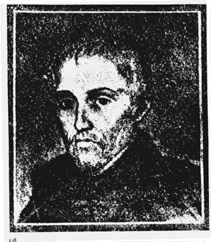 Tomás Luis de Victoria Source: Discogs |
|
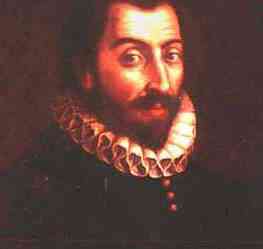 Luca Marenzio Source: Los Angeles Master Chorale |
Born in
1553/54 near Brescia in northern Italy,
Luca Marenzio emphasizes
the significance of the Roman school to the musical Renaissance. Marenzio is
thought to have been composing by 1575, but we pick up
his life in 1578 when he went to Rome to work for Cardinal Cristoforo
Madruzzo as a vocalist. Via whom he came to the notice of the Este family,
among the more significant patrons of the Renaissance period. Upon the death
of Cardinal Luigi d'Este in 1586 he left Ferrara for Verona where he
attended the Accademia Filarmonica, then found employment with Ferdinando I
de' Medici in Florence. Returning to Rome in 1589, he acquired the patronage
of various until making an important trip in 1595. Backing up to where this
history started circa 500 AD in realms under the umbrella of the Eastern
Orthodox Church, we saw the next six centuries pass with relatively little
narrative until the French troubadour, Guillaume (William) IX, circa 1100 AD
followed by 13th
century Notre Dame, France where both secular and sacred music in Western Europe began to
notably burgeon. Come the Burgundian school
expanding into the Franco-Flemish in the 15th century, giving rise to the
musical Renaissance, the Franco-Flemish school early taken to Italy by
such as
Alexander Agricola, thereafter
the Roman school to develop. Come the Franco-Flemish school early
entering Germany via such as
Heinrich Isaac. We've
seen the Venetian school founded by Franco-Flemish composer,
Adrian Willaert. We've
witnessed such as
Nicolas Gombert taking the
Franco-Flemish style to Spain. We've noted the musical Renaissance in full
bloom in England with
Thomas Tallis and
William Byrd from its early roots
in
John Dunstaple.
Russia was yet much buried in a snow bank during the Renaissance, but Poland
joined the rest of Europe w a Renaissance of its own [*]. Thus Marenzio's
appointment as maestro di cappella at the court of Sigismund III Vasa in
Warsaw in 1595 worked to good fortune for all concerned. Marenzio
died shortly upon returning to Rome on 22 August 1599. Though Marenzio wrote sacred
music the madrigal was his bag, completing some 500 of them, published in
numerous of 23
books by Marenzio that were much celebrated throughout Europe. References:
1,
2,
3.
Compositions: 1,
2.
Scores: 1,
2.
Authorship: 'The Complete Five Voice Madrigals' (Gaudia Music 1996); 'The Complete Six Voice Madrigals' (Gaudia Music 2001); 'Opera Omnia' edited by Bernhard Meier & Roland Jackson (American Institute of Musicology 1978).
Marenzio's use of "opera" translates to "work" or "oeuvre" from Latin
("operate"). The title doesn't refer to theatrical or musical opera,
Marenzio dying the year after
Jacopo Peri's
'Dafne' of 1598, generally credited as the first opera. Recordings of: 1,
2,
3,
4.
Audio.
IA.
Further reading:
Brian Robins.
Bibliography: 'Luca Marenzio' by Marco Bizzarini (Ashgate 2003)
*;
'Perspectives on Luca Marenzio’s Secular Music' by M. Calcagno
*.
Other profiles: 1,
2,
3,
4. Dates below
refer to the year of publication if not composition. Luca Marenzio Amatemi Ben Mio 1587 La Gioia/Sigrid Weigl Così nel mio parlar voglio esser aspro 1599 Cruda Amarilli 1595 La Compagnia del Madrigale Crudele acerba inexorabil morte La Venexiana Album: 'Il Nono Libro De Madrigali' Dolorosi Martir 1580 La Compagnia del Madrigale O Rex Gloriae Coro de Cámara de Madrid/Ana Fernández-Vega Madonna, sua mercè, pur una sera 1585 Tutti Cantabile Solo e pensoso i piú deserti campi 1599 La Venexiana Album: 'Il Nono Libro De Madrigali' Veggo, dolce mio bene 1585 Veggo, dolce mio bene Vezzosi Augelli 1584 Vezzosi Augelli |
|
| Born south
of Venice in Chioggia in 1557,
Giovanni Croce
("Cross") continued the Venetian school during the late Renaissance. Croce
sang in choirs in both Chioggia and Venice as a boy. He was certainly
composing by 1585 when he was ordained
into the clergy. In 1590 he became assistant choirmaster at St. Mark's
Basilica beneath composer, Baldassare Donato, assuming the position of
maestro di cappella upon Donato's death in 1603. In the meantime he
published his first book, 'Madrigali Libro Primo', in 1585. Into the
nineties Croce was a member of singing troupe which made itself available for
entertainment at such as banquets and the Carnival in Venice
[*]. In that capacity
he composed masquerades which were a combination of the secular madrigal
with popular songs of the time. One such had been 'Mascarate piacevoli et
ridicolose per il carnevale' ('Delightful Comic Masquerades for Carnival')
in 1590. 'Triaca musicale' ('A Musical Cure-All') arrived in 1595. Both were
performed by I Fagiolini on 'Carnevale Veneziano' issued by Chandos Records
in 2001 [1,
2,
3,
4].
The Venetian Carnival was officially held once a year on the day before Lent
since 1296 AD. The closely related masquerade ball
[1,
2,
3] was held anywhere
anytime someone w a ballroom took the notion. As only dukes, queens and
other face cards had
that kind of space, though the common people celebrated Carnival, masquerade
balls were events for who mattered alone. Other of Croce's nine publications
listed at CPDL included his 1599 'Septem Psalmi poenitentiales sex
vocum' [1,
2]. His last couple of books were collections of motets
for eight voices published in
1603 and 1605 [1,
2]. Though not a major composer in comparison to others, Croce's
works were popularly disseminated throughout much of northern Europe,
including England. He passed away on 16 May
1609, having no role in the Baroque music that was just was emerging in
Europe at the time. References: 1,
2,
3.
Compositions: 1,
2.
Scores.
Discography.
Audio at BBC.
HMR Project. Giovanni Croce 1594 TMEA All State Choir Musica Sacra/Chris Paraskevopoulos Cantores Carmeli/Michael Stenov Cappella Marciana Il Dilettoso Monte Consort Vocale Massimo Annoni 1595 From 'Trica Musicale' I Fagiolini/Robert Hollingworth Trinity Chamber Singers 1597 Cappella Marciana/Marco Gemmani
|
|
|
|
Thomas Morley, a
contemporary of Shakespeare, was born in England in 1557. His father a
brewer, he may have smelled with beer at the local cathedral where he sang
as a boy in Norwich. His career picks up in London in the early seventies
where he studied under
William Byrd,
he apparently employed as a singer in London as well. It's assumed that
studies w Byrd as a teenager included composition. Morley took a
bachelor's degree from Oxford in 1588, soon thereafter becoming an organist
at St. Paul's Cathedral back in London. Nicholas Yonge had meanwhile
published his 'Musica Transalpina' in 1588, a collection of Italian madrigals w English lyrics
that put the island under the spell of the madrigal, such as favored
protestant Tudor
queen, Elizabeth I [*], of particular note
[*], she reigning England from 1558
to her passing in 1603. The madrigal pretty much described music in England
upon the wane of the Renaissance prior to the Baroque period, the latter
given a round date of 1600 for its emergence. Also popular
was the ayre [*]. Morley also composed canzonets [*]
distinguished by him as a lighter style of
madrigal. Morley addressed the canzonet in his first published work of 1593,
'Canzonets or little short songs to three voices' [1,
2,
3].
Come 'The first book of canzonets to two voices' in 1595
[1,
2,
3].
Morley also published the 'First Book of ballets to five voices' in 1595
[1,
2].
The term "ballet" derives from "ballare" which is "to dance" in Latin.
Though this is the first mention of ballet in this history, ballet was at
least a century old by the time of Morley's volume, having developed out of
the ballroom dance, thus of aristocratic heritage, thus to later temporarily
disappear during the years of the French Revolution. Choreographed dance originated
in Italy in the fifteenth century to spread to France. By the time of
Catherine de Médici (1519-1589) ballet was being developed in Russia. The
year after Morley's book of ballets in '95 Queen Elizabeth granted him the
monopoly on printing music in England upon the expiration of
William Byrd's patent. 'A Plaine
and Easie Introduction to Practicall Musicke' ensued the next year in 1597
[1,
2,
3,
4,
5].
In addition to vocal madrigals Morley left behind numerous instrumental and
consort works. The term "concert" arises from the consort and broken
consort, in which Morley was key in developing during the transition from
late Renaissance to early Baroque. The consort simply refers to a group of
instruments all of the same family. The broken consort refers to a group of
instruments consisting of different families, later shifting to what would
become known as chamber music at the height of Baroque. Morley's broken
consort pieces in 'The First Booke of Consort Lessons' published in 1599 are
arrangements of sextets by various composers
[1,
2].
Morley's final book of original compositions was 'The First Booke of Ayres'
in 1600 [1,
2,
3].
In 1601 he published his compilation of English madrigals by various
composers called 'The Triumphs of Oriana' [1,
2,
3,
4;
I Fagiolini;
King's Singers].
He died the next year in October of 1602, the same year
Giulio Caccini
published compositions baroque in 'Le Nuove Musiche'. References for Morley:
1,
2,
3,
4,
5,
Compositions.
Scores: 1,
2.
Publications.
Recordings of: 1,
2,
3,
4,
5,
6.
IA.
Other profiles: 1,
2,
3,
4.
References for ballet: Wikipedia: 1,
2,
3,
4,
5,
6,
7,
8,
9,
10;
other: 1,
2,
3,
4,
5,
6,
7.
Dates below refer to year of publication if not composition. Thomas Morley 8 Fantasias for two instruments 1595 The Early Music Consort of London/David Munrow Dances for Broken Consort 1599 From 'First Booke of Consort Lessons' Leave now mine eyes lamenting 1595 Ernst Stolz Now is the Month of Maying 1595 Cambridge Singers Phillis, I fain would die now 1595 The Clerkes of Oxenford/David Wulstan Sing We and Chant It 1595 The Douglas Frank Chorale
|
||
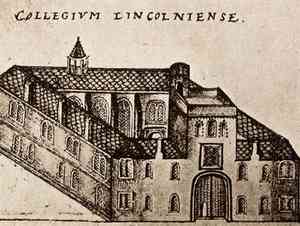 Lincoln College Oxford University 1566 Source: Lincoln College |
It is
thought that late Renaissance composer,
John Dowland,
was born in London in 1563, the year prior to Shakespeare in '64. Like
Shakespeare, Dowland is associated with the Golden Age of Elizabeth I whose
reign stretched from 1558 to her passing in 1603. Unlike Shakespeare he
became a Roman Catholic which was a mixed bag in Elizabeth's Protestant
England insofar as it was both dangerous and not to be so. For Dowland it
wasn't but it won no favors either. We pick up his career in 1580 when he was in the
employment of ambassadors to France, taking him to Paris where he became Catholic before returning to England in 1584. In 1588 Dowland took his
bachelor's degree from Oxford. That would have required subscribing to
articles of the Anglican Church. Recall that Europe's earliest colleges were
the University of Paris emerging about 1150 AD toward the construction of
the Cathedral of Notre Dame begun in 1163 during the reign of King Louis
VII, and Oxford University emerging about 1100 toward the development of a
music department circa 1200 while Notre Dame was yet being built. To the left is a 1566 drawing by Thomas Neale of Lincoln
college, contemporaneous with Dowland and Elizabeth I. He apparently saw
farther things nearer and nearer things farther. Literacy was higher in
Dowland's
England than on the continent for no small period of time. In 1600 the
literacy rate of the common laborer was 90% in England. In 1720 Germany,
where printing had been invented around 1440, four of five men still couldn't sign their
own name. As for Dowland, his 'Frog Galliard' is thought to have seen
publishing circa 1590, recopied by 1594 [US-Washington Folger-Shakespeare Library, Ms.V.b.280
(olim 1610.1):
1,
2;
Facsimile].
"Frog" is likely in reference to Duc d’Alençon who had been a suitor of
Elizabeth's from 1579 to '81, so endeared by her as he was apparently
unattractive, although a good partner at the lively galliard, one of her
favorite dances. The galliard was of recent development in dance
[1,
2] for which
Dowland wrote numerous melodies [*].
Dowland came upon opportunity to perform for the Queen in 1592, the same
year he contributed compositions to Thomas Este's 'The Whole Booke of Psalmes', an extensive collection
in which ten composers participated
[1,
2].
Shakespeare's acting troupe, the Lord Chamberlain’s Men, would perform
numerously at the Queen's court, Shakespeare thought to have written 'The
Merry Wives of Windsor' for Elizabeth published in 1602.
Dowland applied with the Queen again in 1594 when a position as a lutenist
became available. Not landing the job, he headed back to the Continent in
'95 to visit
Luca Marenzio in Rome, which
destination he never made and was back in England in 1596 to apply with
Elizabeth a third time. Striking out a third a time precipitated his path to
becoming the crybaby of Elizabeth's gilded age when he that year published
his instrumental
'Lacrime' ('Lachrimae Pavane') in William Barley's 'A New Book of Tabliture'
[1,
2,
3,
4,
5].
The pavane was a sober court dance of moderate to slower pace which emerged
in the early 16th century to die out before the next. Dowland also
contributed composition to Barley's 1596 'A New Book of Tabliture for the
Orpharion' [1,
2].
The opharion
is a string instrument related to the cittern originating during the
Renaissance. Come Dowland's 'Firste Booke of Songes or Ayres' in 1597
[1,
2,
3,
4].
Albeit Dowland
was highly popular in England he had difficulty acquiring a court position until
Christian IV of Denmark hired him in 1598. Come Dowland's 'Second Booke of
Songs or Ayres' [1,
2,
3] in 1600 containing 'Flow My Tears' [1,
2,
3,
4,
5], a lyricized version of
his 1596 'Lachrimae Pavane'. Queen Elizabeth I died on 24 March 1603.
Dowland's 'Lachrimae, or Seaven Teares' arrived in 1604
in which further versions of his 'Lachrimae' were explored for viol and lute
consort along w several
galliards. Released from service to Christian IV in 1606, he returned to England
where in 1609
he hired on with Lord Howard de Walden, during which period he prepared 'A Pilgrimes Solace' for publishing in 1612
[1,
2,
3].
It seems Dowland composed little after that, even as he finally arrived to
appointment at the royal court of England upon hiring by James I in May of
1612. Shakespeare died four years later on 23 April 1616. Dowland followed a
decade late, buried in London on 20 February 1626.
References encyclopedic: 1,
2;
musical: 1,
2,
3,
4,
5;
books: 1,
2,
3.
Compositions: 1,
2.
Publications: 1,
2,
3.
Tablature: guitar;
'Lachrimae Pavanne' (1596).
Scores: 1,
2;
'Frog Galliard' (c 1590);
'Lachrimae Pavanne' (1596).
Video performances of:
1,
2.
Recordings of: 1,
2,
3,
4,
5;
compilations: 'The Collected Works' by the Consort Of Musicke 2007
*;
'Complete Lute Music' by Nigel North 2008
*;
'Complete Lute Works Volumes 1-5' by Paul O'Dette 1997
*.
Reviews: 'Complete Lute Music' by Nigel North:
'Vol 1: Fancyes, Dreams and Spirits'
*;
'Vol 2: Dowland's Tears'
*;
'Vol.3: Pavans, Galliards and Almains'
*;
'Vol 4: The Queen's Galliard'
*.
Collections: U of Cambridge Digital Library
*.
Internet Archive:
1,
2,
3.
Further reading:
Stile Antico;
Walter Bitner:
1,
2;
Gale-Crawford;
Carolyn McDowell;
Paul O’Dette:
1,
2;
Andrea Valentino.
Bibliography: 'Dowland: Lachrimae (1604)' by Peter Holman (Cambridge U Press 1999)
*;
various.
Other profiles: 1,
2,
3,
4,
5,
6.
Dates below refer to year of publication if not composition. John Dowland Come Again: Sweet Love Doth Now Invite Tenor: William Ferguson Guitar: David Leisner Complete Lute Works Vol 1-5 Lute: Paul O'Dette 1997 Flow My Tears 1600 Soprano: Valeria Mignaco Lute: Alfonso Marin Galliard: The Earl of Essex 1605 Consortium5 Galliards Lute: Paul O'Dette In Darkness Let Me Dwell 1610 From 'A Musical Banquet' Countertenor: Steven Rickards Lute: Dorothy Linell Lachrimae: Seven in 5 Parts 1605 Consortium Violae Weep You No More Sad Fountains From 'Third and Last Booke of Songs' Tenor: Paul Agnew Lute: Christopher Wilson
|
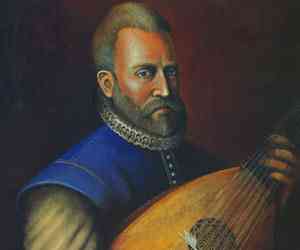 John Dowland Source: Florilegium |
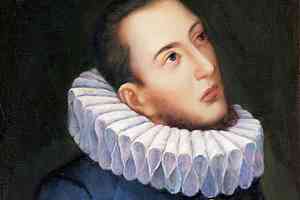 Carlo Gesualdo Source: Singers |
Born on 8
March
1566,
Carlo Gesualdo (also
Gesualdo da Venosa) enjoyed that status which occurs when one's family owns
a principality, namely, Verona in southern Italy, since 1560. The Prince of
Venosa and Count of Conza, upon his elder brother's death in 1584, was also
among the more beloved personalities of the late Renaissance, skilled in
composition, lute and murder. He published his first motet, 'Delicta nostra
ne reminiscaris, Domine' ('Remember Not Our Sins, Lord'), in 1585 at age
nineteen. if the Prince of Verona was also a prince of a
musician as a minor composer, he is often referred to as a prince of darkness as well
[1,
2]. Upon discovering his wife of two years in bed
with another man in 1588 Gesualdo killed both of them, wife by sword, her
lover by gun [1,
2]. Though as a noble Gesualdo was immune from correction, he left
Verona for fear of revenge from the families of his victims. In 1594 he
arrived in Ferrara to publish his first book, 'Madrigali del Venoso Libro
Priomo' [1,
2]. A letter
indicates that he also composed for the Concerto delle Donne
[1,
2,
3] in Ferrara.
Founded by Alfonso II, Duke of Ferrara, the Concerto delle Donne was a trio
of female vocalists popular from 1580 to 1597. Playing instruments as well,
among their venues was the court (private) ballet. The court of Alfonso II was also
host to the Mannerism [1,
2,
3,
4,
5,
6] of the late Renaissance prior to the arrival of the
Baroque. Gesualdo returned to the castled town of what is now
called Gesualdo (in Avellino) in his honor in 1595. He married into the Este
family in 1597, apparently another unhappy relationship. Gesualdo is said to
have suffered from depression in his latter years, there indications that
feelings of guilt for his earlier murders was rearing its head. Along with
keeping a servant whose duty was to beat him "at stool," Gesualdo engaged in
unsuccessful search for relics. He died at his castle in Avellino on 8
September 1613,
having published what some think his best work, his collection of spiritual
madrigals in 'Tenebrae Responsoria' in 1611
[1,
2,
3,
4].
References for Gesualdo: 1,
2,
3,
4,
5,
6.
Chronology.
Compositions: 1,
2.
Scores: 1,
2.
Recordings of: 1,
2,
3,
4,
5,
6,
7.
Further reading: 'Behind the Music' (OBT): 1,
2;
'Prince of Darkness' by Rose;
'Prince of Pain' by Chris Blackford.
Bibliography: 'The Gesualdo Hex: Music, Myth and Memory' by Glenn Watkins (W.W. Norton & Co 2010); 'Gesualdo: the Man and His Music' by Glenn Watkins (Oxford U Press 1973).
Other profiles: 1,
2,
3,
4,
5,
6.
References for ballet: Wikipedia: 1,
2,
3,
4,
5,
6,
7,
8,
9,
10;
other: 1,
2,
3,
4,
5,
6,
7.
Dates below refer to year of publication if not composition. Carlo Gesualdo Ave Dulcissima Maria Ensamble Vocal Européen Philippe Herreweghe Gagliarda del Principe di Venosa The King's Noyse David Douglass Madrigals: Book 6 1611 Ensemble Métamorphoses Maurice Bourbon Miserere Vocalconsort Berlin / James Wood Música sacra a 5 voces Oxford Camerata Jeremy Summerly Tenebrae Responsoria: Omnes amici mei 1611 La Compagnia del Madrigale Tenebrae Responsories for Maundy Thursday 1611 The King's Singers |
|
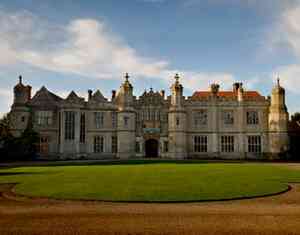 Hengrave Hall |
Baptized on
7 March 1574 in
Brome, England, little is known about
John Wilbye's
early life. Born to a tanner, it isn't known when he acquired employment at
Hengrave Hall
in Suffolk, manor of merchant, Sir Thomas Kitson, who kept a
town house in London as well. This was essentially the hire of Kitson's
wife, Lady Elizabeth Kitson, an amateur lute player who inherited Hengrave
Hall upon Thomas' death in 1603 and would be Wilbye's patroness for another
quarter century from that time. During that time he composed secular vocal
madrigals nigh exclusively. That he wrote no sacred music while with the
Kitsons is likely relevant to the fact that Hengrave Hall was a seat of
Catholic recusancy, that is, refusal to attend Anglican church services. He
might have authored Catholic works in secret like his contemporay,
William Byrd, did, but it seems that Lady Kitson was content with madrigals. Wilbye
published his first book of madrigals at age 24 in 1598 titled 'The First
Set of English Madrigals'. His second book of madrigals, 'The Second Set of
Madrigales', arrived in 1609. These two books of madrigals were his only,
though he wrote a scattered handful of more pieces published otherwise or
copied into manuscript. He wrote a harpsichord version at an unknown time of
John Dowland's earlier lute galliard, 'Frogge' (MS circa 1590). More notable
was 'The Lady Oriana' which is No.16 of
Thomas Morley's assemblage of
madrigals in 'The Triumphs of Oriana' which had been published in 1601.
Wilbye also contributed two songs to William Leighton's 'The Tears or
Lamentations of a Sorrowful Soul' of 1614. Those were No.27 'I am quite
tired with my groans' for three parts and No.49 'O God, the rock of my whole
strength' for four parts. Wilbye remained at Hengrave Hall until the death
of Lady Kitson in 1628, She having been his patroness probably above thirty
years, Wilbye then retired in Colchester until his own passing ten years
later in September of 1638. Having lived beneath the umbrella of Elizabeth I
until her death in 1603, his life encompassed the complete reign of
Protestant King James I (1603-25) and entered that of Protestant King
Charles I.
References: 1,
2,
3.
Publications.
Compositions.
Scores: 1,
2.
Recordings of: 1,
2,
3,
4.
IA.
Documentaries: 'Draw on Sweet Night'.
Other profiles: 1,
2,
3. John Wilbye Draw on sweet night The Hillard Ensamble Flora Gave Me Fairest Flowers Wicker Park Choral Singers The Frogge From John Dowland's 'Frogge' Harpsichord: Colin Tilney Lady When I Behold The Consort of Musicke Lady your words do spite me The King's Singers
|
|
| Baptized on 25
Oct 1576 in Elsted,
Thomas
Weelkes published his first volume of madrigals in 1597, 'First Set of Madrigals'
(for 3, 4, 5 and 6 voices) [1,
2,
3]. Weelkes was born into the fade of the late
Renaissance about to instrumentally shift into the Baroque on the Continent.
In Weelkes' England, meanwhile, the vocal madigral yet reigned with the ayre
also popular. Weelkes had been in the
employment of a courier, one Edward Darcye, until winning an appointment at
Winchester College as an organist in 1598, the same year he published
'Eight Balletts and Madrigals' [1,
2].
'Madrigals of 5 and 6 Parts' arrived in 1600
[1,
2,
3,
4]. Upon obtaining his degree from New College,
Oxford, in 1602 Weelkes took employment as an organist at Chichester
Cathedral. Along with room and board Weelkes was paid some 15 pounds (about
23 dollars) annually. Weelkes was friend to
Thomas Morley to
whom he dedicated his madrigalian lament, 'Death Hath Deprived Me' [*],
in 1602 upon
Morley's death
in October. Weelkes' fourth and final book, 'Airs or Fantastic
Spirits', appeared in
1608 [1,
2,
3].
It isn't known just when Weelkes composed services for the Anglican Church,
largely canticles and anthems not commercially published. Most are thought
to have arrived after 1608. The anthem [1,
2] of the Anglican Church (having no
relation to such as later national anthems) closely corresponds to the motet
of the Roman Catholic. Anthems by Weelkes include 'Alleluia, I Heard a
Voice' [*],
'Gloria in Excelsis Deo' [*],
'Hosanna to the Son of David' [*] and
'O Lord, Arise' [*]. Weelkes is said to have been an alcoholic. That or but a rouser is
unknown, but in 1616 he was fired from his post for drunken behavior and
swearing. Soon rehired, Weelkes remained at Chichester until his death on 20
Nov 1623. References: 1,
2,
3,
4,
5.
Audio.
Compositions / scores: 1,
2.
Recordings of: 1,
2,
3,
4,
5,
6,
7;
compilations: 'Anthems'.
Bibliography: 'The Anthems of Thomas Weelkes' by David Brown 1964-65
*;
'Thomas Weelkes' by Edmund Fellowes 1916
*.
Other profiles: *.
Thomas Weelkes As Vesta was from Latmos hill descending 1601 The King's Singers Death hath deprived me Vox Luminis Gloria in excelsis Deo King s College Choir Hark All Ye Lovely Saints Above CD Singers Hosanna to the Son of David The Oxford Camerata The Nightingale William and Mary Women's Chorus O Care, thou wilt despatch me Consort of Musicke/Anthony Rooley O Lord, Arise The Oxford Camerata Sing We at Pleasure Bell'Arte Singers/Brenda Uchimaru When David Heard (That Absalom Was Slain) Tewkesbury Abbey Schola Cantorum
|
||
|
This section of the history of early classical music suspends with Thomas Weelkes. |
|
Early Blues 2: Vocal - Other Instruments
Modern Blues 2: Vocal - Other Instruments
Early Jazz 1: Ragtime - Bands - Horn
Early Jazz 2: Ragtime - Other Instrumentation
Modern 4: Guitar - Other String
Modern 5: Percussion - Other Orchestration
Modern 7: Latin Jazz - Latin Recording
Modern 8: United States 1960 - 1970
Modern 9: International 1960 - 1970
LatinLatin Recording 2: The Caribbean
Latin Recording 3: South America
Popular Music
Rock & Roll
The Big Bang - Fifties American Rock
Total War - Sixties American Rock
Classical - Medieval to Renaissance
Classical - Baroque to Classical
Classical - Romantic to ModernJazz Early - Ragtime - Swing Jazz
Boogie Woogie - Doo Wop - R&B - Rock & Roll - Soul - Disco
Sixties American Rock - Popular
Latin Recording - EuropeLatin Recording - The Caribbean - South America
![]()
vfssmail (at) gmaill (dot) com